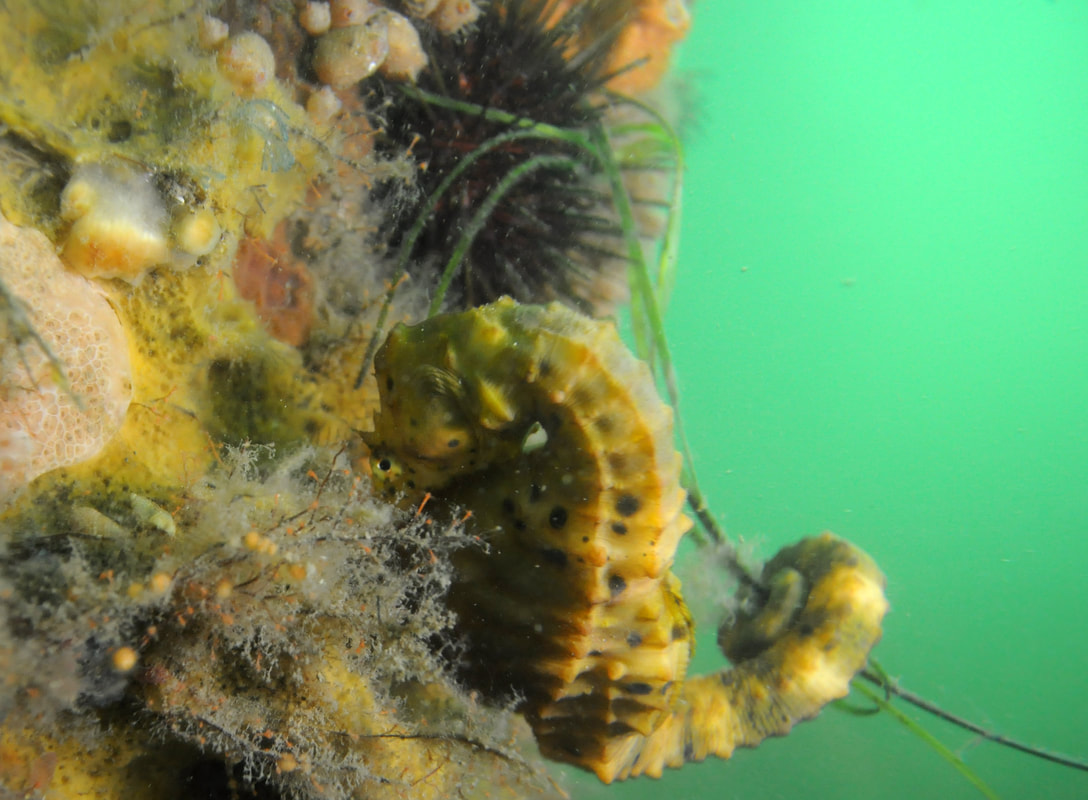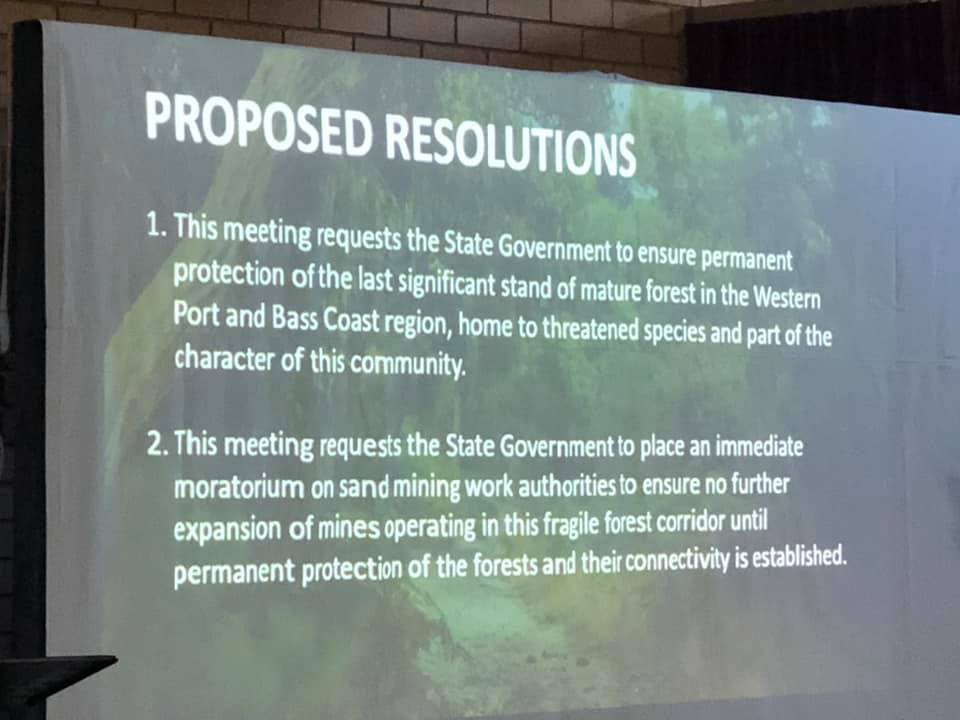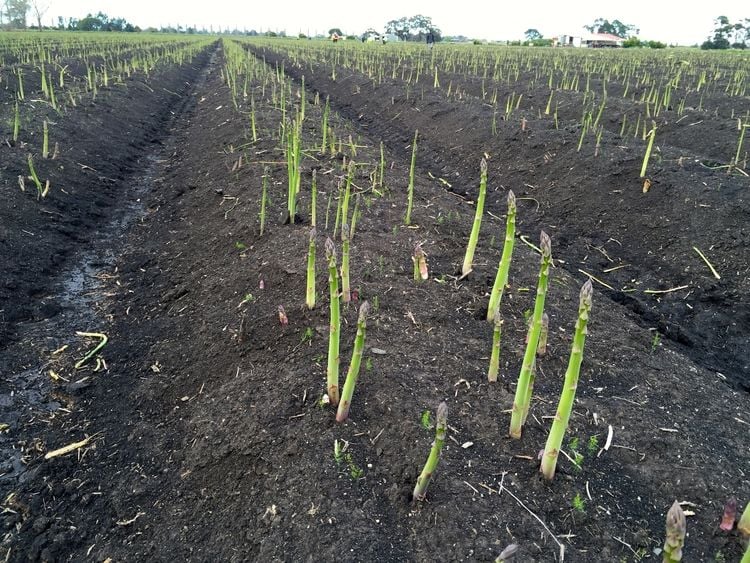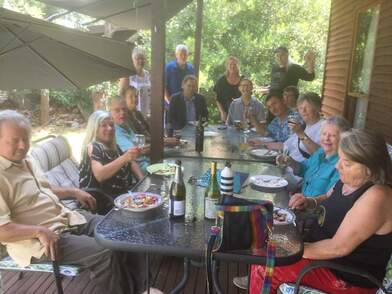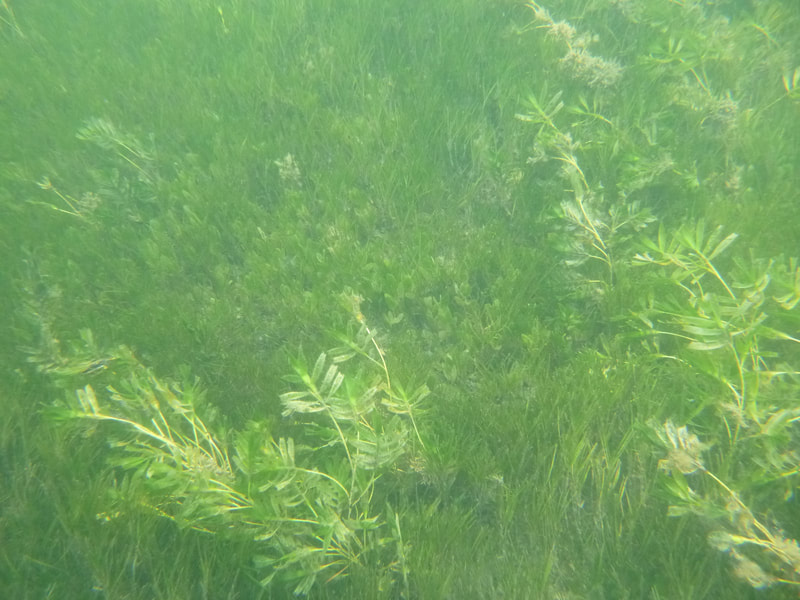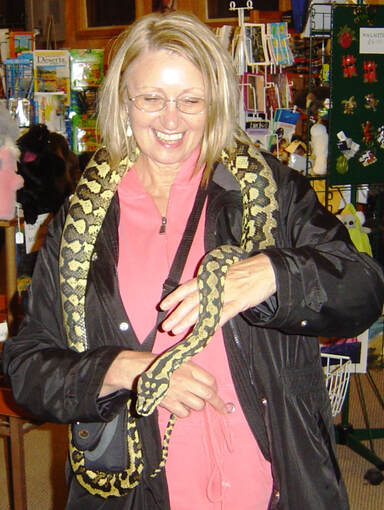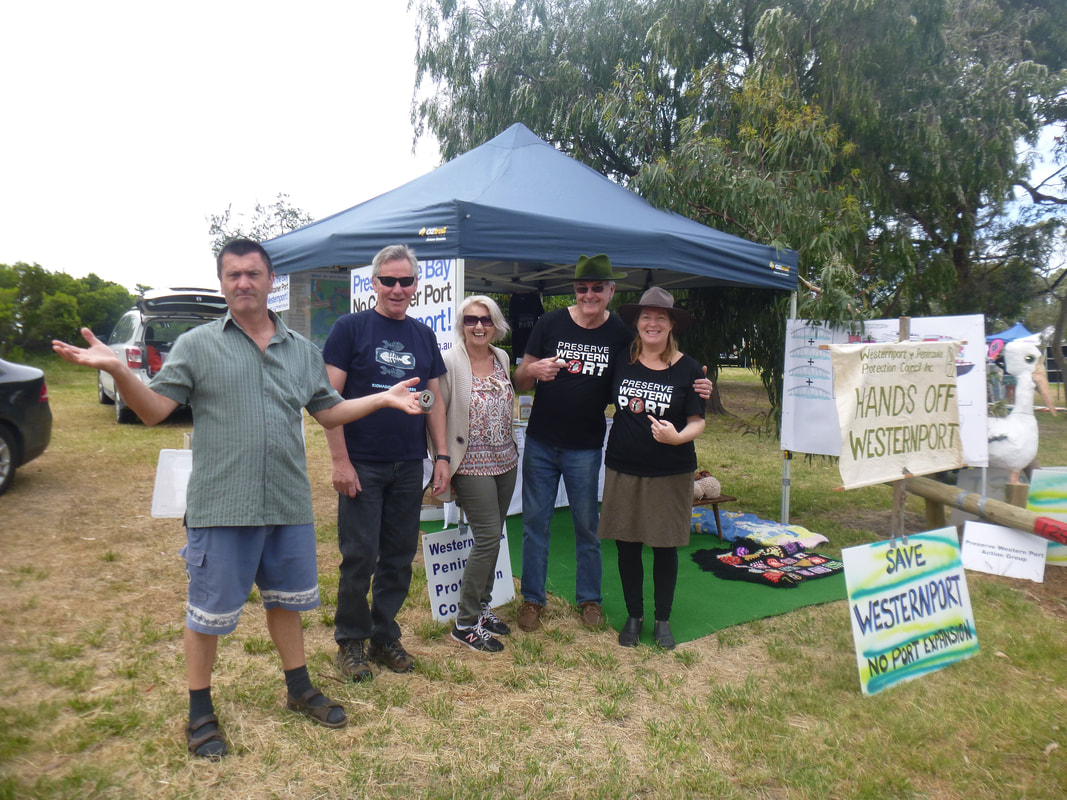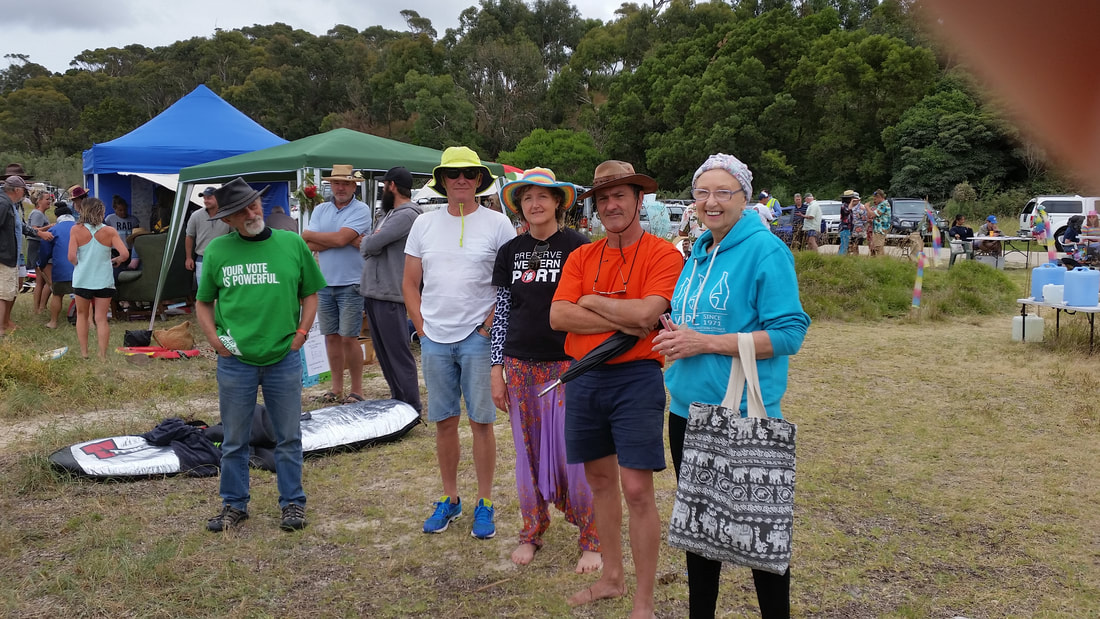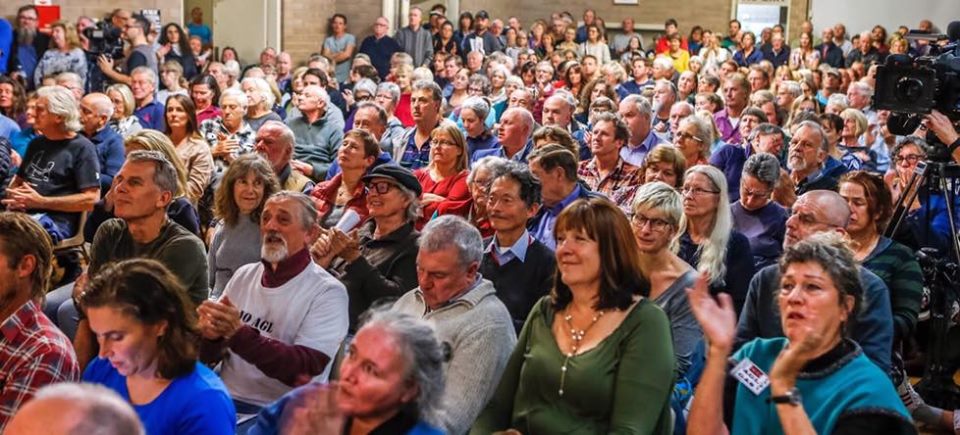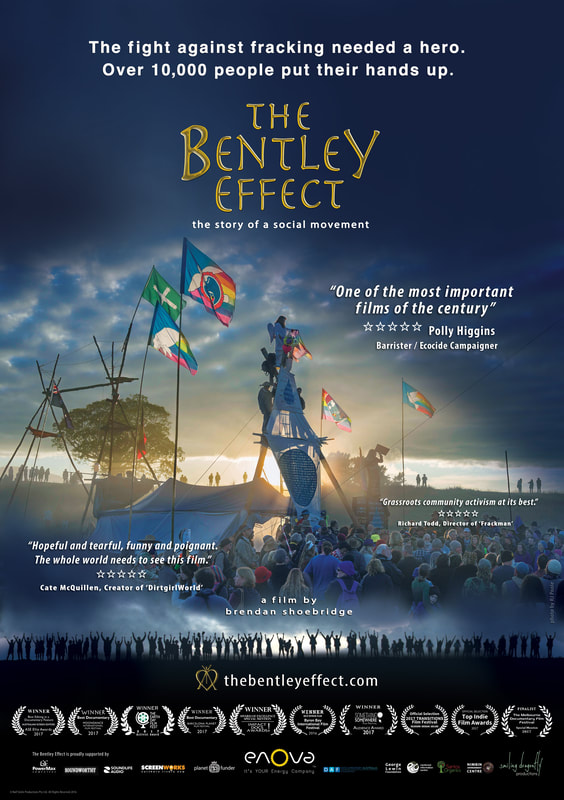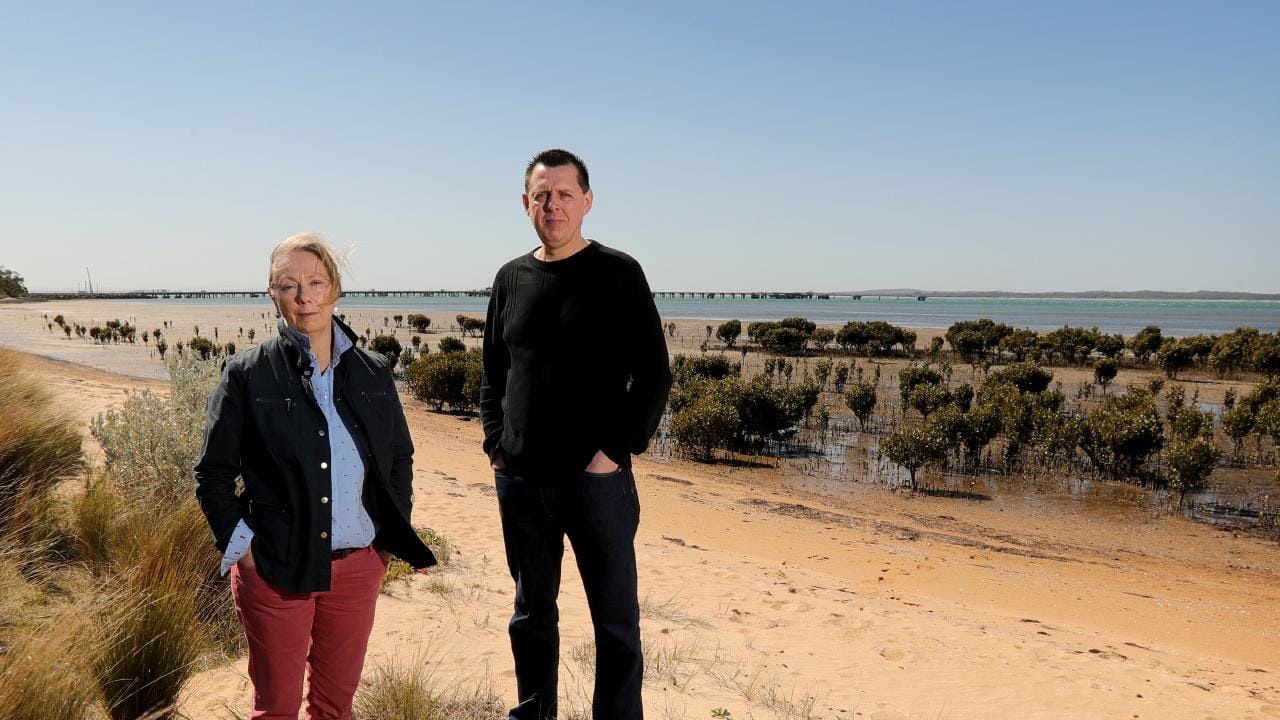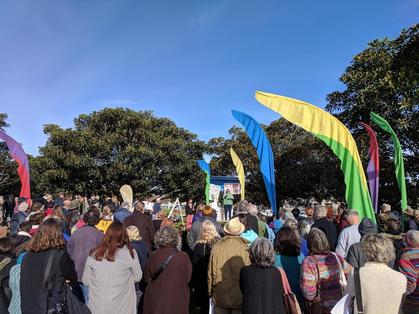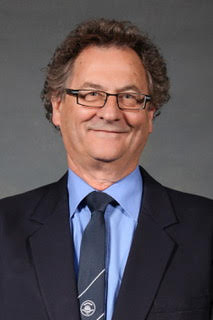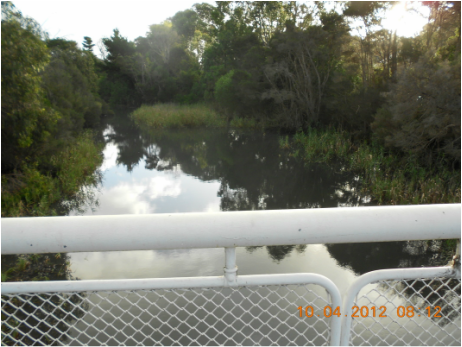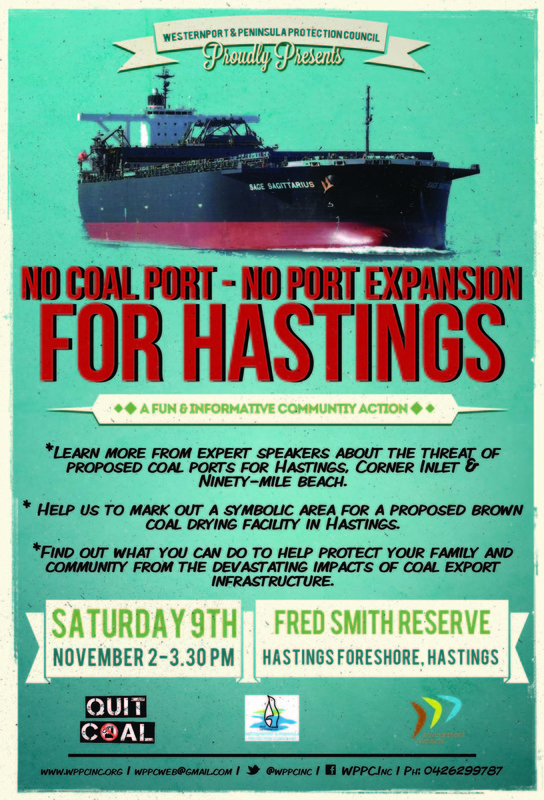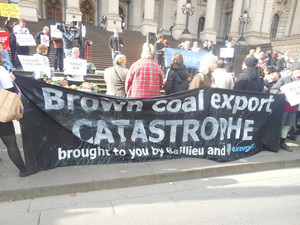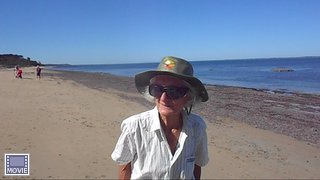Westernport and Peninsula Protection Council Inc

In the spirit of reconciliation WPPC acknowledges the Bunerong/ Boon Wurrung and their connections to land, sea and community. We pay our respect to their Elders past and present and extend that respect to all Aboriginal and Torres Strait Islander peoples today. Sovereignty has never been ceded.
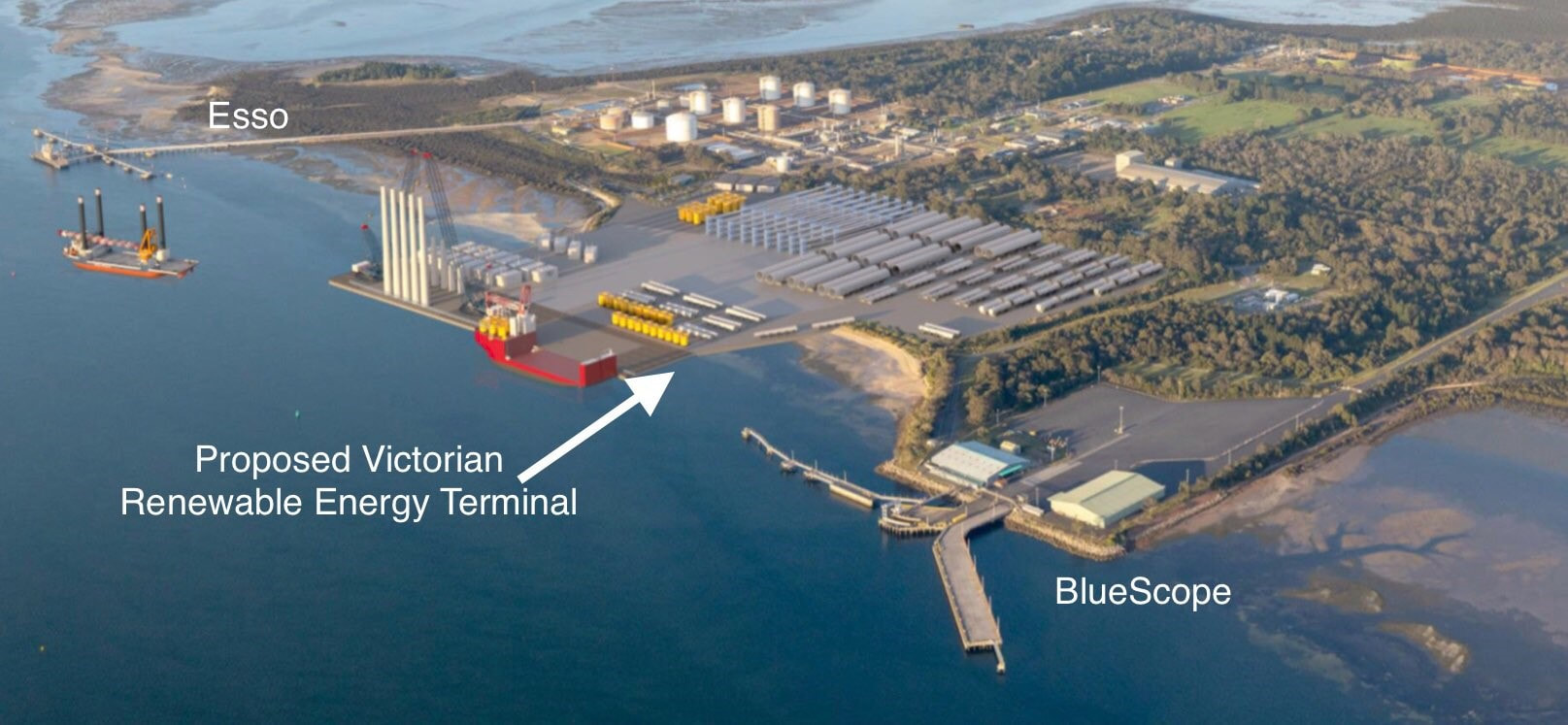
Westernport and Peninsula Protection Council Inc
AGM 10.15am for a 10.45am start
Member’s Lunch 12.15pm
Sunday 14th January 2024
Balnarring Hall (Small Hall) 3041 Frankston -Flinders Rd
The proposed Vic Renewable Energy Terminal (VRET) in Hastings to facilitate Offshore Windfarms in Bass Strait has been cancelled.
Details of the project and why it was stopped by the Federal government will be outlined at the AGM by WPPC President Julia Stockigt, who has been following the project and attending the Port of Hastings’ briefings since 2022, when the Port of Hastings was named ‘the preferred location’ from which to stage Australia’s first offshore Windfarm.
While we support renewable energy, we’re concerned that construction of the VRET calls for large areas of reclamation and dredging with unknown consequences for the Bay.
Our 17 minute film will also be shown featuring Tom McConville, Brian Thomas and Gidja Walker produced by Sandy Milne with funding from Parks Victoria
Membership due and payable by cash: $10 or $15 on the day of the AGM All welcome- Please RSVP to receive lunch and for numbers to [email protected]
Incorporation Association Reg. No. A15886H ABN 984 610 14730 PO Box 9 Hastings Vic 3915
| wppc_media_release_march_23.pdf |
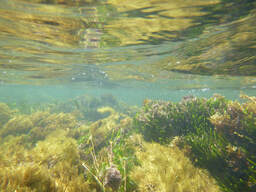
ACT FOR WESTERN PORT
An initiative from VNPA, WPPC, EV, PHILLIP ISLAND CONSERVATION SOCIETY,
SAVE WESTERNPORT, The BIOSPHERE
October 2022
Please sign up as an individual or organization or business.
An initiative from VNPA, WPPC, EV, PHILLIP ISLAND CONSERVATION SOCIETY,
SAVE WESTERNPORT, The BIOSPHERE
October 2022
Please sign up as an individual or organization or business.

Westernport and Peninsula Protection Council Inc
AGM
10.30am Sunday 22nd January 2023
Balnarring Small Hall
Guest Speaker Catherine Watson
‘Secrets of the Westernport Woodlands’
Catherine first became involved with Save Western Port Woodlands when she published a couple of articles about a campaign to preserve the old Holden Proving Ground as habitat for endangered species. The campaigners gradually realised the entire forest corridor between Lang Lang and Grantville was under threat from a surge in sand mining.
Catherine was so outraged that she crossed the line from professional journalist to activist.
Our AGM will be immediately followed by a
Special General Meeting 11.45am to Vote on a motion to adopt the ACNC model rules click on this blue link to read the model rules:
* Constitution for a charitable company limited by guarantee | ACNC
in place of our constitution* to meet current requirements
followed by member’s lunch 12.00pm
please RSVP for lunch 0425 707 448
WPPC is 51 years old and continues to actively protect Westernport Bay and surrounds.
We encourage organisational, family and individual memberships, due in January.
our constitution:
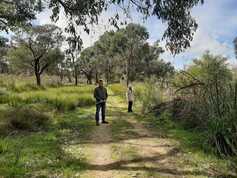
Save Westernport Woodlands Need your help now
Summer Dec2022 -2023
Below is a letter you can cut and paste and adapt to use yourself to send to the Ministers Below to show this is an important issue. Through our letter writing stalls WPPC and interested people have sent dozens of similar letters to a variety of ministers.
Summer Dec2022 -2023
Below is a letter you can cut and paste and adapt to use yourself to send to the Ministers Below to show this is an important issue. Through our letter writing stalls WPPC and interested people have sent dozens of similar letters to a variety of ministers.
| wppc_letter_save_westernport_woodlands__081022.doc |
Westernport Bryozoan Reef Project
Adrian Flynn and the rest of Fathom Pacific the company that fulfilled the marine pest surveys that we got a grant forhave been working on an extremely important project.
The two talks members of WPPC have attended have been thrilling. These Bryozoan reefs are profoundly important for habitat and may be the secret to Westernport's extra edge!
Fathom Pacific Say: To the best of our knowledge and that of international experts in the field of bryozoan research, the bryozoan reef community of Western Port is unique in the state of Victoria and Australia. Based on research to date, this biotope is likely to be of global significance as there are no other records of fenestrate (net-like) bryozoans forming continuous reef structure, with high vertical relief, in shallow water occurring anywhere else in the world. https://fathompacific.com/project-spotlight/western-port-bryozoan-reef-project/
Adrian Flynn and the rest of Fathom Pacific the company that fulfilled the marine pest surveys that we got a grant forhave been working on an extremely important project.
The two talks members of WPPC have attended have been thrilling. These Bryozoan reefs are profoundly important for habitat and may be the secret to Westernport's extra edge!
Fathom Pacific Say: To the best of our knowledge and that of international experts in the field of bryozoan research, the bryozoan reef community of Western Port is unique in the state of Victoria and Australia. Based on research to date, this biotope is likely to be of global significance as there are no other records of fenestrate (net-like) bryozoans forming continuous reef structure, with high vertical relief, in shallow water occurring anywhere else in the world. https://fathompacific.com/project-spotlight/western-port-bryozoan-reef-project/
Western Port Woodlands – pre-election action needed
We continue to join our friends and colleagues on the Eastern side of the Bay to promote and lobby for the protection of these unique woodlands. We don't want to see them turned into (unnecessary) sand mines that destroy this unique and pristine habitat and leach chemicals into the bay. Although Dandy Premix was granted permission for sand mining in May this year, there are many other proposals in place - and we aim to stop them.
Koalas have recently been found in the area, and their genetics are being tested to see if they are from the original Strezleki population. If they are, this will provide further strong evidence of the unique diversity in this area.
A recent ‘meet the candidates’ day at Bass Coast showed that the Labor government has not committed to supporting the woodlands, yet other local candidates have.
How you can help - email your local member, and/or Daniel Andrews asking them to protect this critical woodlands biolink, as there is plenty of sand available elsewhere (quote the 2022 study by Edward Minty BSc, MSc Geology). Also, that they protect of the ex-Holden (Vinfast) proving grounds, contained within this site. See Westernport Woodlands website https://www.savewesternportwoodlands.org/
There is a letter on our website https://www.wppcinc.org/ that you could use.
Better Protections for Westernport – pre-election action needed
We are working with colleagues from the Victorian National Parks Association, Environment Victoria, Save Westernport, Friends of Phillip Island, Westernport Biosphere and others c on a framework ‘to effectively manage, restore, and legally protect the marine and coastal environment of Western Port Bay and establish an ecologically sustainable economy for the future’. We aim to have ecology at the forefront of any future planning decisions in Westernport, through government endorsement of the framework.
How you can help – go to the new website, actforwesternportbay.au
to sign up – and if you know any business who might also sign, please speak with them!
Esso - proposal to generate electricity with, or burn unused ethane
We support Save Westernport’s campaign to State Government to refuse this scheme by Esso, which Esso says is due to low demand for ethane, a by-product of natural gas. Objections include that it is an untested methodology, will increase carbon (and potentially toxic) emissions in Westernport by 6%, increase 24 hour noise levels, particularly across to French Island, and remove up to one hectare of native vegetation.
Council has agreed that this needs an EES before it can be approved by State government.
https://www.mpnews.com.au/2022/06/27/shire-no-to-essos-bid-for-power/
How you can help: Contact the State Planning Minister, Ms Lizzie Blandthorn [email protected] to request an EES for this project.
The Hastings hydrogen trial – The $500 million trial to convert brown coal to hydrogen, funded by State and Federal governments with Kawasaki Heavy Industries, has been finalised. We understand very little hydrogen was produced, and there was a fire on board the ship, not reported to the public. https://fuelcellsworks.com/news/fire-aboard-hydrogen-ship/ A (July 2022) document on the future of Victoria’s commercial ports mentions hydrogen and wind projects in Hastings, but we have no further information. There are far more viable options than producing hydrogen from brown coal.
The good news - no mention of a container port for Hastings in the strategic document!
Community education activities
Good news!! 🤸 Video production
We obtained a CoastCare grant to produce 2 short videos on Westernport’s diversity and how to help protect it. We aim to have these completed for our AGM in January 2023.
What you can do to help – we welcome help to edit information for production. Donations towards the creation of an interactive map to complement this work are most welcome!
There have been many whale sightings around and close to the Bay, especially heading east
We continue to join our friends and colleagues on the Eastern side of the Bay to promote and lobby for the protection of these unique woodlands. We don't want to see them turned into (unnecessary) sand mines that destroy this unique and pristine habitat and leach chemicals into the bay. Although Dandy Premix was granted permission for sand mining in May this year, there are many other proposals in place - and we aim to stop them.
Koalas have recently been found in the area, and their genetics are being tested to see if they are from the original Strezleki population. If they are, this will provide further strong evidence of the unique diversity in this area.
A recent ‘meet the candidates’ day at Bass Coast showed that the Labor government has not committed to supporting the woodlands, yet other local candidates have.
How you can help - email your local member, and/or Daniel Andrews asking them to protect this critical woodlands biolink, as there is plenty of sand available elsewhere (quote the 2022 study by Edward Minty BSc, MSc Geology). Also, that they protect of the ex-Holden (Vinfast) proving grounds, contained within this site. See Westernport Woodlands website https://www.savewesternportwoodlands.org/
There is a letter on our website https://www.wppcinc.org/ that you could use.
Better Protections for Westernport – pre-election action needed
We are working with colleagues from the Victorian National Parks Association, Environment Victoria, Save Westernport, Friends of Phillip Island, Westernport Biosphere and others c on a framework ‘to effectively manage, restore, and legally protect the marine and coastal environment of Western Port Bay and establish an ecologically sustainable economy for the future’. We aim to have ecology at the forefront of any future planning decisions in Westernport, through government endorsement of the framework.
How you can help – go to the new website, actforwesternportbay.au
to sign up – and if you know any business who might also sign, please speak with them!
Esso - proposal to generate electricity with, or burn unused ethane
We support Save Westernport’s campaign to State Government to refuse this scheme by Esso, which Esso says is due to low demand for ethane, a by-product of natural gas. Objections include that it is an untested methodology, will increase carbon (and potentially toxic) emissions in Westernport by 6%, increase 24 hour noise levels, particularly across to French Island, and remove up to one hectare of native vegetation.
Council has agreed that this needs an EES before it can be approved by State government.
https://www.mpnews.com.au/2022/06/27/shire-no-to-essos-bid-for-power/
How you can help: Contact the State Planning Minister, Ms Lizzie Blandthorn [email protected] to request an EES for this project.
The Hastings hydrogen trial – The $500 million trial to convert brown coal to hydrogen, funded by State and Federal governments with Kawasaki Heavy Industries, has been finalised. We understand very little hydrogen was produced, and there was a fire on board the ship, not reported to the public. https://fuelcellsworks.com/news/fire-aboard-hydrogen-ship/ A (July 2022) document on the future of Victoria’s commercial ports mentions hydrogen and wind projects in Hastings, but we have no further information. There are far more viable options than producing hydrogen from brown coal.
The good news - no mention of a container port for Hastings in the strategic document!
Community education activities
Good news!! 🤸 Video production
We obtained a CoastCare grant to produce 2 short videos on Westernport’s diversity and how to help protect it. We aim to have these completed for our AGM in January 2023.
What you can do to help – we welcome help to edit information for production. Donations towards the creation of an interactive map to complement this work are most welcome!
There have been many whale sightings around and close to the Bay, especially heading east
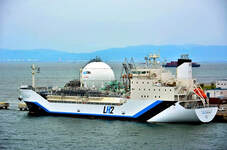
From January
Mark the arrival of the Suiso Frontier Hydrogen Ship to Westernport
……and your opposition
9.45am Thursday 20th January Woolleys Beach Crib Point
WE DEMAND:
Julia Stockigt:O425 306 830 [email protected] https://savewesternport.org/
BYO: signs, parasol, sunblock, water, morning tea
Mark the arrival of the Suiso Frontier Hydrogen Ship to Westernport
……and your opposition
9.45am Thursday 20th January Woolleys Beach Crib Point
WE DEMAND:
- That results of HESC marine pest surveys under host-pier at BlueScope Hastings be publicly released
- An Environmental Bond— in case Westernport is negatively impacted
- The project’s commercial stage must be scrapped due to threats from: Marine pests, Dredging, Hydrogen from Dirty Brown Coal, and environmentally and economically unsound Carbon Sequestration, CCS
Julia Stockigt:O425 306 830 [email protected] https://savewesternport.org/
BYO: signs, parasol, sunblock, water, morning tea
Incorporated Association Reg No.
A15886H ABN 984 610 14730
Press Release
Westernport Groups ask for an environmental bond as hydrogen ship arrives tomorrow Thursday 20th 10am Woolleys Beach Crib Pt
Westernport Supporters will mark the first arrival of the hydrogen ship Suiso Frontier on Thursday 20th January at 10am at Woolleys Beach Crib Point. They will be demanding:
- Results of the HESC marine pest surveys under host-pier at BlueScope Hastings be publically released
- An Environmental Bond
- The commercial stage of the project be scrapped because: of the threat of marine pests, dredging, the hydrogen is from dirty brown coal, and carbon sequestration is environmentally and economically unsound.
Introduced regionally by ships from Japan, these pests have not been found in Westernport in recent surveys. If introduced, these pests could prove devastating to the Bay’s diversity, ecology, fish stocks and water quality”. KG
“We don’t want ships from Japan entering Westernport to export hydrogen long-term because of the risk of introducing these serious marine pests, which have already been introduced to Port Phillip Bay,” says Karri Giles[2], Secretary, WPPC.
WPPC and Save Westernport have just completed marine pest surveys at Yaringa Boat Harbour and Stony Point Jetty. These surveys[3] were funded by a Commonwealth Community Environment Program Grant through Greg Hunt MP’s Office and conducted by Fathom Pacific Pty Ltd, in September 2021. “I am delighted that funding from the Federal Government’s Community Environment Programme has enabled this important project to be completed and I am glad that the surveys found no evidence of these significant marine pests in Westernport Bay” The Hon Greg Hunt MP
Dr Adrian Flynn from Fathom Pacific says: “Western Port is largely free of high priority marine pests of concern in Victoria…Increased shipping activity and recreational boating in Western Port has the potential to increase the risk of marine pest introductions. Therefore, surveillance and monitoring should increase commensurate with the increasing risk.”
The Commonwealth Community Environment Program grant to WPPC was initially intended to survey under BlueScope pier, the site of the HESC Hydrogen export trial. The grant was specifically planned to look for marine pests before Hydrogen ships from Japan arrived. When BlueScope refused access for the project, the grant survey was changed to new locations.
The Victorian Government has also recently surveyed for marine pests at San Remo and Hastings Marina [4] [5] under Richard Stafford-Bell’s team at Agriculture Victoria. These results, together with citizen science surveys at Flinders, Point Leo, and Merricks, completed as part of WPPC and Save Westernport’s project, [6] indicate that the marine pest of highest significance was Pacific oysters. While this species is of concern, it is far less voracious and not as rampant as two other introduced species.
“We need to learn from the mistakes of the past. Japanese woodchip ships have brought in Japanese kelp and Northern Pacific seastars, believed to have been spread by hull and ballast water” and they have dramatically degraded Port Phillip Bay and parts of Tasmania”, says Karri Giles.
“Port Phillip Bay went from zero to 165 million Northern Pacific seastar between 1997 and 2000, then they ate out their food supply over vast areas in Port Phillip Bay”. [7]
“We must protect Westernport from being carpeted by millions of Northern Pacific seastars or blanketed by Japanese kelp or both.” said Karri Giles.
“We urge the State and Federal Governments to reject plans for a commercial stage of this hydrogen export pilot project, because the threat of marine pests and dredging for deeper draught ships is too great.” Julia Stockigt
Environmental groups have been told that ships of deep draught would be used for a commercial stage, which would mean possibly prohibitive amounts of dredging. In fact, Suiso Frontier is a smaller ship that was especially built to come safely into Hastings for the trial.
“The $500 million project to convert brown coal to hydrogen is by no means a green energy project. $100 million towards the trial is funded by Australian taxpayers – there’s no future in brown hydrogen, and it is putting Westernport Bay at risk”, says Julia Stockigt, Secretary Save Westernport
“It’s money that would be far better invested in truly valuable “green energy” projects that protect our future, and that global energy markets increasingly demand.” JS
CONTACTS:
Both WPPC and Save Westernport were recently involved with the statewide “No AGL” campaign, which secured over 10,000 individual EES submissions, and 30,000 signatures against the project, registering the amount of support and concern that Victorians have for the Westernport catchment. AGL completed Benthic surveys in North Arm and at Crib Point for the EES. A lot of data was provided, and no sightings of these two marine pests were mentioned and reporting them is required.
Karri Giles, Secretary, Westernport and Peninsula Protection Council Inc.
0425 707 448 [email protected] www.wppcinc.org
Julia Stockigt, Secretary Save Westernport Inc.
O425 306 830 [email protected] https://savewesternport.org/
[1] Kawasaki Letters to WPPC about marine pests https://drive.google.com/file/d/1fSnLi0cV1zbFyAhsaVX0aINfIuPhEEFz/view?usp=drivesdk
[2] Karri Giles Grad Dip Geog &Env Sci
[3] Flynn. A. Fathom Pacific 2021 Western Port Marine Pest Survey Oct 2021 https://drive.google.com/file/d/1TVN51O3cLj6c_0RyhUXFNsrU-odnJxe_/view?usp=drivesdk
[4] Invasive Marine Species Distribution Project Hastings Summary Report April 2021 Venturani. M. Professional Diving Services https://drive.google.com/file/d/1T4Rs25iCgbAyAw-tqSDq2DErUjol2KAc/view?usp=drivesdk
[5] Invasive Marine Species Distribution Project San Remo Summary Report April 2021 Venturani m. Professional Diving Services https://drive.google.com/file/d/1cuHBSdEVjA-APaH6Tna9hqOKad85gfuo/view?usp=drivesdk
[6] Visit our website for a write up on the citizen science work https://www.wppcinc.org/marine-pests-and-westernport.html
[7] Parry. G.2004 Changes in distribution and abundance of Asterias amurensis in Port Phillip Bay 1999-2003.
Westernport and Peninsula Protection Council Inc
AGM and Nod to our 50th Anniversary
Sunday 9th January 2022 10.30am
zoom link
WPPC is inviting you to a scheduled Zoom meeting.
Join Zoom Meeting
https://us02web.zoom.us/j/85719971723?pwd=MXNYYy9JbytJeHg5S01CeUJURFU2Zz09
Meeting ID: 857 1997 1723
Passcode: 298255
Meeting ID: 857 1997 1723
Passcode: 298255
Find your local number: https://us02web.zoom.us/u/kdNhDCcnUQ
Agenda WPPC AGM 2022 January 9th
- Welcome
- Report for 2021
- Showcasing Marine Pest work
- Question time
- Apologies
- Minutes of last AGM
- Treasurer's Report
- Election of Office Bearers
- History snapshot the last 50 years
- Discussion
- Close
Our marine pest surveying have just been completed
|
The survey work that Adrian Flynn and others from Fathom Pacific has done by agreement with Aegir Divers as part of WPPC and Save Westernport's grant is completed. A report complete with list of marine pests will be forthcoming. This can be added to quite a few surveys done in Westernport recently and these have found that the most significant pests are pacific oyster and sea lettuce, and that Victoria's two most significant pests are absent. These two bad pest that we must try and avoid are Northern Pacific Seastar and Undaria: Japanese Kelp. To avoid bringing them into Westernport we must stop hydrogen exports to Japan. The actions of all boat owners are important too. Please look at the link below. Kawasaki have announced that they will do marine pest surveys under BlueScope Pier. We welcome this and thank them for responding to our request that we think is reasonable.
https://www.marinepests.gov.au/recreation-community |
For more information about Marine Pests and Westernport click the button below
The Otama Submarine is listing in Hastings waters. It has on board batteries as big as a small car.
WPPC strongly urge The Oberon Association to sign over ownership to Parks Vic so they can take measures to protect The Bay. The Western port Oberon Association has failed to attract enough money to turn the submarine into a tourist attraction and has plenty of years. We do not want the submarine on land if it isn't a mueseum. It may become a great reef for marine ecology once made safe and sunk.
July 2021
We have been shortlisted in our application to Parks Vic to interview past and current WPPC members, recording their voices to inspire others to participate in environmental volunteering. This recording will also serve as a visual snapshot and archive of the immense work of WPPC since the early 1970's.
From this work, we aim to work with new volunteers to develop short, inspiring educational snapshots of Westernport diversity. We hope this will be launched at a celebration of our 50th Anniversary.
Kawasaki Annouces Marine Pest Monitoring Plans
Good news! Kawasaki have announced that they will do marine pest monitoring pre-and-post hydrogen trial. This is a response to a letter of request initiated by WPPC and jointly signed by 8 environment groups and our follow up work including the grant awarded to us and Save Westernport applied for by Julia, Karri and Chris Chandler. This grant was from Greg Hunt's Office.
The grant awarded by Federal government to WPPC and Save Westernport will now be used for a snapshot to determine the presence/ absence of marine pets at Stony Point. We'll keep you updated on the progress. Read their response here:
The grant awarded by Federal government to WPPC and Save Westernport will now be used for a snapshot to determine the presence/ absence of marine pets at Stony Point. We'll keep you updated on the progress. Read their response here:
WPPC Submission Marine and Coastal
Save Westernport Woodland epetition and video below
Please share the video with friends. It's a great summary of the campaign to save Bass Coast's last coastal forest.
https://app.frame.io/presentations/698e765c-a2b1-4017-b60d-bb05bfcdefd9
Sign online!If you haven’t already signed our petition to stop sand mining in Western Port’s last coastal forest, here’s your chance.
The Victorian Parliament has now published our e-petition at
https://www.parliament.vic.gov.au/council/petitions/electronic-petitions/view-e-petitions/details/12/356
Please spread the word.
The petition closes on June 22, the same date as our paper petition, which will also be presented to Parliament. Woodlands or mines:
our line in the sandThe last strip of significant woodland left in Bass Coast Shire is under threat from a surge in sand mining activities.
Under the Victorian Government's Strategic Extractive Resources Areas proposal, sand mining would take precedence over conservation of this fragile habitat and the wishes of local communities.
Once these forests are gone, they're gone forever.
But it’s our call, and we’re drawing a line in the sand.
This rare woodland is too precious to lose.
With the support of 14 environmental and community groups, plus the Bass Coast Shire Council, we call on the Victorian Government to preserve this fragile coastal corridor from the ravages of sand mining.
The Government's own research reveals 700 years' supply of suitable sand, almost all of it outside woodland areas.
We can win this “once in forever” opportunity.
(And tell our children how we won.)
Above: Rare grass trees flowering in the Grantville Conservation Reserve, November 1919. Photo: Hartley Tobin
Grass trees, some hundreds of years old, bagged for relocation, sand quarry adjoining the Grantville Conservation Reserve, November 2020.
Save Westernport Woodlands Reserve Public Meeting Saturday 22nd May 2021 Corinella Hall
Things you can do to help Save The Westernport Woodlands:
1. Sign the petition
2. Join Save Westernport Woodlands
3. Donate to the Save Westernport Woodlands Campaign
4. Let others Know about what is happening
5. Write to the Planning Minister
6. Write to Local State MP Jordan Crugnale
7. Provide Feedback to the Distinctive AreasLandscape Consultation
1. Sign the petition
2. Join Save Westernport Woodlands
3. Donate to the Save Westernport Woodlands Campaign
4. Let others Know about what is happening
5. Write to the Planning Minister
6. Write to Local State MP Jordan Crugnale
7. Provide Feedback to the Distinctive AreasLandscape Consultation
Karri Giles' Speech as delivered at the
Save Westernport Woodland Public Meeting
Saturday 22nd May 2021 Corinella Hall
It is the size of the Westernport Woodland Reserve that makes this the most exciting campaign. A big diverse reserve means less edge-effect, a great big gene pool and enough diversity so that species that prefer differing conditions can gradually replace others.
Ferns that don’t mind more frequent flood events with climate change can colonize. Trees that survive more frequent bushfire, or whose seed stays alive in the soil longer, move-in. So there are plants growing in all the niches,
-plants providing all the ecosystem services they do. Resilience.
Small reserves are too isolated and vulnerable.
This would also be a valuable seed bank.
Along with Save Westernport who also endorse this campaign, my group WPPC: Westernport and Peninsula Protection Council worked on the No-AGL campaign. WPPC focused on the pipeline from Crib Pt to Pakenham and the plight of the growling-grass frog, southern brown bandicoot, swamp skink and southern Toadlet. And we did this in the absence of The Department of the The Environment whose submission was suppressed.
If the government’s stance is No Net Loss Of vegetation when you see the development in the South East of Melbourne and the loss of the habitat for these species, The Westernport Woodland Reserve is vitally needed.
Some of us here today helped save Devilbend Reservoir in the heart of the Mornington Peninsula, 1005ha as a whole. MW wanted to sell off all the farmland and Dr Brian Cuming from our group WPPC put forward a simple map saying “This is the Community Vision Let’s save it as a whole.” The fact is retaining the farmland meant more scope for recreation to be accommodated without threatening the core ecology with phytothphora etc.
We joined with The Fishers and Horse groups, Aboriginal People and Bird and other environment groups.
When the State Government saw all those groups could sit at the same table and make decisions together, and after a lot of public events and political persuasion, they handed the management over to Parks Vic and The Community Devilbend Foundation together. It is now a successful Natural Features Reserve with fishing from canoes, walking, horse riding, and bike riding with more than 50,000 visitors a year. It is an important resource for the education sector. It provides employment and is good for the local economy. It hosts 150 birds, including blue-billed duck, freckled duck and breeding sea eagles.
The Westernport Woodlands are significantly better ecologically than Devilbend and therefore protection of the Flora and Fauna here needs to be the first and second priority and education and recreation third and fourth priority.
In my lifetime in Melbourne has gone from over 2 million to over 5 million and has largely lost the backyard. The grandchildren of the kids I teach in Cranbourne could walk through the heathy Westernport Woodland Reserve; they could see wildflowers, a skink, a yellow robin, an echidna. People talk about nature hunger. My theory is that being an omnivore, seeing diversity lifts our spirits, reassures and excites us. That is fantastic at lowering our health budget and mental health budget. Healthy Parks Healthy People.
It is the State Government’s rhetoric, the bigger the population the more and bigger parks they need to provide.
Save Westernport Woodland Public Meeting
Saturday 22nd May 2021 Corinella Hall
It is the size of the Westernport Woodland Reserve that makes this the most exciting campaign. A big diverse reserve means less edge-effect, a great big gene pool and enough diversity so that species that prefer differing conditions can gradually replace others.
Ferns that don’t mind more frequent flood events with climate change can colonize. Trees that survive more frequent bushfire, or whose seed stays alive in the soil longer, move-in. So there are plants growing in all the niches,
-plants providing all the ecosystem services they do. Resilience.
Small reserves are too isolated and vulnerable.
This would also be a valuable seed bank.
Along with Save Westernport who also endorse this campaign, my group WPPC: Westernport and Peninsula Protection Council worked on the No-AGL campaign. WPPC focused on the pipeline from Crib Pt to Pakenham and the plight of the growling-grass frog, southern brown bandicoot, swamp skink and southern Toadlet. And we did this in the absence of The Department of the The Environment whose submission was suppressed.
If the government’s stance is No Net Loss Of vegetation when you see the development in the South East of Melbourne and the loss of the habitat for these species, The Westernport Woodland Reserve is vitally needed.
Some of us here today helped save Devilbend Reservoir in the heart of the Mornington Peninsula, 1005ha as a whole. MW wanted to sell off all the farmland and Dr Brian Cuming from our group WPPC put forward a simple map saying “This is the Community Vision Let’s save it as a whole.” The fact is retaining the farmland meant more scope for recreation to be accommodated without threatening the core ecology with phytothphora etc.
We joined with The Fishers and Horse groups, Aboriginal People and Bird and other environment groups.
When the State Government saw all those groups could sit at the same table and make decisions together, and after a lot of public events and political persuasion, they handed the management over to Parks Vic and The Community Devilbend Foundation together. It is now a successful Natural Features Reserve with fishing from canoes, walking, horse riding, and bike riding with more than 50,000 visitors a year. It is an important resource for the education sector. It provides employment and is good for the local economy. It hosts 150 birds, including blue-billed duck, freckled duck and breeding sea eagles.
The Westernport Woodlands are significantly better ecologically than Devilbend and therefore protection of the Flora and Fauna here needs to be the first and second priority and education and recreation third and fourth priority.
In my lifetime in Melbourne has gone from over 2 million to over 5 million and has largely lost the backyard. The grandchildren of the kids I teach in Cranbourne could walk through the heathy Westernport Woodland Reserve; they could see wildflowers, a skink, a yellow robin, an echidna. People talk about nature hunger. My theory is that being an omnivore, seeing diversity lifts our spirits, reassures and excites us. That is fantastic at lowering our health budget and mental health budget. Healthy Parks Healthy People.
It is the State Government’s rhetoric, the bigger the population the more and bigger parks they need to provide.
|
| |||
| agm_presentation_gidja_2021.pptx |

WPPC’s AGM
Sunday 21st February 2021 10.30am On Zoom
You are invited to the WPPC AGM 10,30am Sunday 21st February 2021 on Zoom
Special guest speaker Botanist and Artist Gidja Walker
Discussion on the Ecology of Westernport
Due to restrictions we have to socially distance, which means it is impossible to give you a cup of tea and biscuit and there is a restriction on numbers, so we thought it was more comfortable and safer at home on zoom.
Please ensure that you use your correct name when signing in, for the minutes. You will be muted as you join, but we have scheduled two sections for feedback, questions and ideas, and would like people to put any comments or questions in the chat during the AGM.
Join Zoom Meeting
https://us02web.zoom.us/j/81518665972?pwd=Y2RySUFVMDRRUWoybXNCSHVHNm1XZz09
Meeting ID: 815 1866 5972
Passcode: 593003
One tap mobile
+13126266799,,81518665972#,,,,*593003# US (Chicago)
+13462487799,,81518665972#,,,,*593003# US (Houston)
Dial by your location
+1 312 626 6799 US (Chicago)
+1 346 248 7799 US (Houston)
+1 669 900 6833 US (San Jose)
+1 929 205 6099 US (New York)
+1 253 215 8782 US (Tacoma)
+1 301 715 8592 US (Washington DC)
Meeting ID: 815 1866 5972
Passcode: 593003
Find your local number: https://us02web.zoom.us/u/kbm0fCpb8D
Agenda for AGM February 21st 2021ZOOM
Welcome
Report for 2020
Showcasing some work
Apologies
Minutes of last AGM
Treasurer's Report
Election of Office Bearers
What is coming up
Ideas from members
Guest Speaker – Gidja Walker
Close
Guest Speaker- Gidja Walker
Discussion of the Ecology of Westernport Bay
Gidja is a well-known, active local botanist, and Artist and educator, a long-term supporter of WPPC and a foundational member of the Southern Peninsula Indigenous Flora and Fauna Association (SPIFFA).
Gidja has been instrumental in mapping and enhancing the protection of many areas of the Peninsula, including Tootgarook swamp. She described the Moonah woodland EVC and worked closely with us on the current NO AGL Gas campaign.
Sunday 21st February 2021 10.30am On Zoom
You are invited to the WPPC AGM 10,30am Sunday 21st February 2021 on Zoom
Special guest speaker Botanist and Artist Gidja Walker
Discussion on the Ecology of Westernport
Due to restrictions we have to socially distance, which means it is impossible to give you a cup of tea and biscuit and there is a restriction on numbers, so we thought it was more comfortable and safer at home on zoom.
Please ensure that you use your correct name when signing in, for the minutes. You will be muted as you join, but we have scheduled two sections for feedback, questions and ideas, and would like people to put any comments or questions in the chat during the AGM.
Join Zoom Meeting
https://us02web.zoom.us/j/81518665972?pwd=Y2RySUFVMDRRUWoybXNCSHVHNm1XZz09
Meeting ID: 815 1866 5972
Passcode: 593003
One tap mobile
+13126266799,,81518665972#,,,,*593003# US (Chicago)
+13462487799,,81518665972#,,,,*593003# US (Houston)
Dial by your location
+1 312 626 6799 US (Chicago)
+1 346 248 7799 US (Houston)
+1 669 900 6833 US (San Jose)
+1 929 205 6099 US (New York)
+1 253 215 8782 US (Tacoma)
+1 301 715 8592 US (Washington DC)
Meeting ID: 815 1866 5972
Passcode: 593003
Find your local number: https://us02web.zoom.us/u/kbm0fCpb8D
Agenda for AGM February 21st 2021ZOOM
Welcome
Report for 2020
Showcasing some work
Apologies
Minutes of last AGM
Treasurer's Report
Election of Office Bearers
What is coming up
Ideas from members
Guest Speaker – Gidja Walker
Close
Guest Speaker- Gidja Walker
Discussion of the Ecology of Westernport Bay
Gidja is a well-known, active local botanist, and Artist and educator, a long-term supporter of WPPC and a foundational member of the Southern Peninsula Indigenous Flora and Fauna Association (SPIFFA).
Gidja has been instrumental in mapping and enhancing the protection of many areas of the Peninsula, including Tootgarook swamp. She described the Moonah woodland EVC and worked closely with us on the current NO AGL Gas campaign.
Gas Pipeline Threatens Asparagus Farms, Bushland and Frogs
Media Release
Gas Pipeline Threatens Asparagus Farms, Bushland and Frogs.
Dr Mary Cole an expert witness at the Crib Pt Gas Import Jetty and Pipeline Environmental Effects Statement Panel Hearing says the pipeline could spread cinnamon fungus a threat to asparagus farms, high-status bushland and frogs.
"The 57km pipeline works bring a risk of much wider-spread destruction as the controls for cinnamon fungus, which destroys much vegetation, including asparagus which is highly susceptible to it and amphibian chytrid fungus, that kills frogs, are inadequate. There is no economically viable mitigation that can protect the asparagus industry, critically endangered amphibians or endangered habitat from damage caused by the installation of the proposed pipeline from Crib Point to Pakenham. " Dr Mary Cole Agpath 2020
The Koo Wee Rup/Dalmore region south east of Melbourne produces more than 95% of Australia’s total asparagus crop (Australian Asparagus council AAC, 2020). The black peaty soils of this area are considered the best asparagus growing soils in the world. The silky texture of the soil and the lack of sand particles allow the asparagus spears to emerge undamaged making them highly prized around the world.[1]
Asparagus is highly susceptible to infestation by Phytophthora species. It is known to be present in the agricultural land but the extent of its distribution is unknown. As it is a water mould which relies on movement in ground water for distribution, it can be spread very easily on equipment, by moving soil from contaminated to clean areas and by people movement on their shoes. Movement between farms is considered carefully by all farmers.
Asparagus farmers are aware of the threat of Phytophthera cinnamoni and use biosecurity protocols and hygiene, which means specific procedures designed to prevent its spread. These include ensuring that infected soil, water and/or plant material are removed from machinery, vehicles, equipment and footwear before they enter uninfected areas.
The 30metre wide 57km AGL-APA gas pipeline, with a footprint of approximately 171hectares is proposed to run alongside asparagus farms right through the Koo Wee Rup region. Dr Mary Cole, a highly qualified fungal scientist submitted to the panel hearing as an expert witness for Westernport and Peninsula Protection Council, a group with a 50 year history. In response, the proponents AGL and APA tabled a document November 18th 2020 which revised their biosecurity protocols. The panel asked Dr Mary Cole to respond and this is a summary of her opinions tabled November 30th 2020:
6. SUMMARY OF OPINION
Summary of Opinions:
1) Revised mitigations do not address the potential spread of either pathogen along the length of the proposed pipeline.
2) Restricted soil surveying is not sufficient to understand the distribution of either pathogen, but P. cinnamomi in particular, along the proposed pipeline.
3) Washdown sites do not consider the use of portable bunded washdown facilities. Therefore, the potential to spread contaminated water along the proposed pipeline corridor remains very high.
4) The chytrid fungus is considered globally the most destructive fungal pathogen of modern times. There is no cure post infection.
5) The cinnamon fungus is a major pathogen of asparagus and this site produces 95% of Australia’s asparagus crop, known global as the best in the world in quality. There is no cure post infection.
6) There is no economically viable mitigation that can protect the asparagus industry, critically endangered amphibians or endangered habitat from damage caused by the installation of the proposed pipeline from Crib Point to Pakenham.
a) There is a high risk of spread to the amphibian chytrid fungus, Batrachochytrium dendrobatidis. The infective propagules of the pathogen move freely in water and wet soil. No survey of infection appears to be available in the Report.
b) Mitigation as written in the Technical report B is not sufficient to protect the amphibian population.
c) Mitigation would need to be carried out at ‘research’ level of containment and would be improbable in a commercial enterprise.
d) These is a high risk of spread of the pathogen, P. cinnamomi. This pathogen moves freely in water and wet soil.
Gas Import Jetty & Pipeline Project
e) Many of the Australian native plant species are highly susceptible to infection by the pathogen so spread of the pathogen is likely in vegetation and farming areas.
f) Mitigation measures as described in the Technical Report B are inadequate. No mapping of infection along the proposed pipeline is apparent. Washdown areas are not obvious and there is no description of how the wash down areas are to be constructed and how the potentially contaminated soil and water is to be contained.
g) A complete 200m survey along the length of the proposed pipeline easement is necessary. Plant and equipment will need to be washdown before moving between infected and clean areas. Washdown will be necessary between farm boundaries to protect agricultural land from cross infection. A detailed methodology of washdown and containment is necessary. [2]
Frogs
“It is likely that amphibian chytrid fungus could be spread to growling grass frog and Southern Toadlet populations (and other frogs) from the pipeline works. This is because the infective propagules of the pathogen move freely in water and wet soil. (Cole 2020) the pipeline goes through the centre of their current distribution There have been a total of 185 recordings of Growling Grass Frog within five kilometres of the Pipeline Works area (EES Document). The works sections are eight hundred metres long, and the mitigation measures focus on wildlife handlers alone. “ Karri Giles Secretary Westernport and Peninsula Protection Council
The Lawyers for the proponents cross-examined Dr May Cole and asked her if she agreed that the way the chytrid fungus was spread was through frogs being handled by humans who had picked up an infected frog first, Dr Mary Cole and she said “No I disagree, it moves in water”. Despite having their ignorance exposed, their revised biosecurity protocol did not include a revision of mitigation measures for the Endangered Growling Grass Frog’s threat from amphibian chytrid fungus and no survey of the pathogen is mentioned.
“The Westernport and Peninsula Protection Council’s view is that The Crib Point Gas Import Jetty and Pipeline Proposal’s likely effects are significant and unacceptable and it should not go ahead. The threat to asparagus businesses and high-status bushland from Phytophthora cinnamoni is unacceptable. The Threat to many species of frogs including The endangered Growling Grass frog from Amphibian Chytrid fungus is likewise unacceptable.
We as a volunteer-based environment group have done been doing The State Government’s job. They are not providing enough of their own expert witnesses to this panel “Karri Giles Secretary WPPC
Bushland
Fig 1 Degree of loss in native bushland from Phytophthera cinnamoni Dept Agriculture 2020 with hand drawn pipeline
This map and a similar one for the Crib Pt end, show a high-to moderate status bushland dying-off slowly along our coastline.
[1] Australian Asparagus Council News online. 2020. Nichols, M.A. (1990) Asparagus on the world scene, Acta Hortic:271,25-32.
[2] Mary Cole Supplementary Expert Report in the Matter of: Environmental Effects Statement by AGL & APA Proposed 271 Gas Import Jetty and pipeline Project. 2020.
Gas Pipeline Threatens Asparagus Farms, Bushland and Frogs.
Dr Mary Cole an expert witness at the Crib Pt Gas Import Jetty and Pipeline Environmental Effects Statement Panel Hearing says the pipeline could spread cinnamon fungus a threat to asparagus farms, high-status bushland and frogs.
"The 57km pipeline works bring a risk of much wider-spread destruction as the controls for cinnamon fungus, which destroys much vegetation, including asparagus which is highly susceptible to it and amphibian chytrid fungus, that kills frogs, are inadequate. There is no economically viable mitigation that can protect the asparagus industry, critically endangered amphibians or endangered habitat from damage caused by the installation of the proposed pipeline from Crib Point to Pakenham. " Dr Mary Cole Agpath 2020
The Koo Wee Rup/Dalmore region south east of Melbourne produces more than 95% of Australia’s total asparagus crop (Australian Asparagus council AAC, 2020). The black peaty soils of this area are considered the best asparagus growing soils in the world. The silky texture of the soil and the lack of sand particles allow the asparagus spears to emerge undamaged making them highly prized around the world.[1]
Asparagus is highly susceptible to infestation by Phytophthora species. It is known to be present in the agricultural land but the extent of its distribution is unknown. As it is a water mould which relies on movement in ground water for distribution, it can be spread very easily on equipment, by moving soil from contaminated to clean areas and by people movement on their shoes. Movement between farms is considered carefully by all farmers.
Asparagus farmers are aware of the threat of Phytophthera cinnamoni and use biosecurity protocols and hygiene, which means specific procedures designed to prevent its spread. These include ensuring that infected soil, water and/or plant material are removed from machinery, vehicles, equipment and footwear before they enter uninfected areas.
The 30metre wide 57km AGL-APA gas pipeline, with a footprint of approximately 171hectares is proposed to run alongside asparagus farms right through the Koo Wee Rup region. Dr Mary Cole, a highly qualified fungal scientist submitted to the panel hearing as an expert witness for Westernport and Peninsula Protection Council, a group with a 50 year history. In response, the proponents AGL and APA tabled a document November 18th 2020 which revised their biosecurity protocols. The panel asked Dr Mary Cole to respond and this is a summary of her opinions tabled November 30th 2020:
6. SUMMARY OF OPINION
Summary of Opinions:
1) Revised mitigations do not address the potential spread of either pathogen along the length of the proposed pipeline.
2) Restricted soil surveying is not sufficient to understand the distribution of either pathogen, but P. cinnamomi in particular, along the proposed pipeline.
3) Washdown sites do not consider the use of portable bunded washdown facilities. Therefore, the potential to spread contaminated water along the proposed pipeline corridor remains very high.
4) The chytrid fungus is considered globally the most destructive fungal pathogen of modern times. There is no cure post infection.
5) The cinnamon fungus is a major pathogen of asparagus and this site produces 95% of Australia’s asparagus crop, known global as the best in the world in quality. There is no cure post infection.
6) There is no economically viable mitigation that can protect the asparagus industry, critically endangered amphibians or endangered habitat from damage caused by the installation of the proposed pipeline from Crib Point to Pakenham.
a) There is a high risk of spread to the amphibian chytrid fungus, Batrachochytrium dendrobatidis. The infective propagules of the pathogen move freely in water and wet soil. No survey of infection appears to be available in the Report.
b) Mitigation as written in the Technical report B is not sufficient to protect the amphibian population.
c) Mitigation would need to be carried out at ‘research’ level of containment and would be improbable in a commercial enterprise.
d) These is a high risk of spread of the pathogen, P. cinnamomi. This pathogen moves freely in water and wet soil.
Gas Import Jetty & Pipeline Project
e) Many of the Australian native plant species are highly susceptible to infection by the pathogen so spread of the pathogen is likely in vegetation and farming areas.
f) Mitigation measures as described in the Technical Report B are inadequate. No mapping of infection along the proposed pipeline is apparent. Washdown areas are not obvious and there is no description of how the wash down areas are to be constructed and how the potentially contaminated soil and water is to be contained.
g) A complete 200m survey along the length of the proposed pipeline easement is necessary. Plant and equipment will need to be washdown before moving between infected and clean areas. Washdown will be necessary between farm boundaries to protect agricultural land from cross infection. A detailed methodology of washdown and containment is necessary. [2]
Frogs
“It is likely that amphibian chytrid fungus could be spread to growling grass frog and Southern Toadlet populations (and other frogs) from the pipeline works. This is because the infective propagules of the pathogen move freely in water and wet soil. (Cole 2020) the pipeline goes through the centre of their current distribution There have been a total of 185 recordings of Growling Grass Frog within five kilometres of the Pipeline Works area (EES Document). The works sections are eight hundred metres long, and the mitigation measures focus on wildlife handlers alone. “ Karri Giles Secretary Westernport and Peninsula Protection Council
The Lawyers for the proponents cross-examined Dr May Cole and asked her if she agreed that the way the chytrid fungus was spread was through frogs being handled by humans who had picked up an infected frog first, Dr Mary Cole and she said “No I disagree, it moves in water”. Despite having their ignorance exposed, their revised biosecurity protocol did not include a revision of mitigation measures for the Endangered Growling Grass Frog’s threat from amphibian chytrid fungus and no survey of the pathogen is mentioned.
“The Westernport and Peninsula Protection Council’s view is that The Crib Point Gas Import Jetty and Pipeline Proposal’s likely effects are significant and unacceptable and it should not go ahead. The threat to asparagus businesses and high-status bushland from Phytophthora cinnamoni is unacceptable. The Threat to many species of frogs including The endangered Growling Grass frog from Amphibian Chytrid fungus is likewise unacceptable.
We as a volunteer-based environment group have done been doing The State Government’s job. They are not providing enough of their own expert witnesses to this panel “Karri Giles Secretary WPPC
Bushland
Fig 1 Degree of loss in native bushland from Phytophthera cinnamoni Dept Agriculture 2020 with hand drawn pipeline
This map and a similar one for the Crib Pt end, show a high-to moderate status bushland dying-off slowly along our coastline.
- The consequences of Phytophthera cinnamoni infection of a susceptible ecological community will usually be the following:
- major disruption of community structure;
- extinction of populations of some flora species;
- a modification of the structure and composition of ecological communities;
- a massive reduction in primary productivity; and
- for dependent flora and fauna, habitat loss and degradation.[3]
[1] Australian Asparagus Council News online. 2020. Nichols, M.A. (1990) Asparagus on the world scene, Acta Hortic:271,25-32.
[2] Mary Cole Supplementary Expert Report in the Matter of: Environmental Effects Statement by AGL & APA Proposed 271 Gas Import Jetty and pipeline Project. 2020.
- DISEASE IN NATURAL ECOSYSTEMS CAUSED BY PHYTOPHTHORA CINNAMOMI BACKGROUND DOCUMENT for the THREAT ABATEMENT PLAN 2009 Australian Government
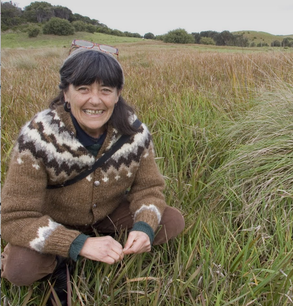 Gidja Walker Botanist, Educator, Artist
Gidja Walker Botanist, Educator, Artist
EES - Crib Point Gas Import Jetty & Pipeline (AGL)
WPPC has submitted to the EES for the Crib Point Gas Import Jetty and Pipeline inquiry
See our response to the EES below.
We are going to speak to that submission at the Panel Hearing on November 19th 2020. You can watch by accessing the link on the Engage Victoria Website. Sandy Milne, Karri Giles and Gidja Walker are the team that are preparing our presentation for the Panel Hearing. This will be a summary of our submission, which seems to have unique information. We were part of a team of environmental groups and tasked with focusing on terrestrial biodiversity which is poorly represented in submissions.
We also have engaged Dr Mary Cole as an Expert Witness. She will give her presentation supported by Barrister James Kewley, in the same time slot: 10.15am until 1pm.
Dr Mary Cole ‘s Summary of Opinion
• a) There is a high risk of spread to the amphibian chytrid fungus, Batrachochytrium dendrobatidis. The infective propagules of the pathogen move freely in water and wet soil. No survey of infection appears to be available in the Report.
• b) Mitigation as outlined in the Technical report B is not sufficient to protect the amphibian population.
• c) Mitigation would need to be carried out at ‘research’ level of containment and would be improbable in a commercial enterprise.
• d) There is a high risk of spread of the pathogen, P. cinnamomi. This pathogen moves freely in water and wet soil.
• e) Many of the Australian native plant species are highly susceptible to infection by the pathogen so spread of the pathogen is likely in vegetation and farming areas.
REMINDER:
The Public Hearing for EES
commenced on Monday 12 October and will run for 10 weeks.
To watch the Hearings live each day, go to https://engage.vic.gov.au/crib-point-IAC
At the top it says ‘How to access the Hearing’
Click on
‘Crib Point IAC - Hearing Link’
Type in your email address, and then click on the Zoom link to watch the Hearing from 10 am each day, (except Fridays)
See our website for our submission.
https://www.wppcinc.org/REMINDER:
WPPC AGM Jan deferred to February 2021
Guest Speaker: Gidja Walker
Ecologist, Artist, Educator
From Alone to Support- Responding to the independent advisory committee
overseeing submissions to agl’s environmental effects statement on their
proposed crib point gas import and processing plant.
“WHAAT...?” was our first response, when faced with a daunting 11,000
pages of documents. Each section references technical reports, maps and
risk assessments, some with conflicting methodology or information.
This, on top of a six week response timeline during COVID restrictions,
with no human to human contact.
For many, this sudden sinking feeling was combined with what Doctors for
the Environment refer to as ‘solastagia’ (IAC Submission number
2136, p.8), where people form a strong, personal attachment to a place
that provides them with a sense of security, safety and identity.
Threatened loss can lead to feelings of grief and helplessness. I
can’t help but think of Aboriginal communities, with their intricate
and life supporting connection to land. In a different way, we feel it
too.
Things slowly began to look up, as we reached out through social media
and video technology,building on our existing alliance with Environmental Victoria,
Victorian National Parks Association, Save Westernport, Philip Island conservation Society
and French Island colleagues and Environmental Justice Alliance.
Together we broke the task into smaller sections, agreed areas of
expertise, shared resources, identified where we needed further support,
reviewed and debriefed on progress, and celebrated our efforts in
getting our respective responses in on time...whew!!
Reading through the submissions is reassuring. In a time where Federal
and State governments once again promote ‘fossil fuel led economic
recovery’, people are saying the opposite. Around 10,000 people
submitted to the IAC that they are concerned for climate change and want
to see Westernport’s environment preserved and enhanced for the
future. We know that represents only a sample of people who care about
Westernport.
WPPC’S contribution, on terrestrial and freshwater diversity with
regard to cinnamon fungus and amphibian chytrid fungus, is unique. Karri
Giles has undertaken significant work in reaching out to local experts,
such as Gidja Walker our SPIFFA colleague, and sourcing our expert
witness, Dr. Mary Cole for the IAC video hearing on 19 November. Karri,
Gidja and Sandy will be briefly speaking at the hearing, supported by
Mary Cole, who will present her report, supported by barrister James Kewley.
You can view Mary’s report here..
https://s3.ap-southeast-2.amazonaws.com/hdp.au.prod.app.vic-engage.files/3916/0159/9192/Mary_Cole_Phytophthera_Cinnamon_Amphiboulous_Chytrid_Fungus.pdf
and listen to the IAC hearing here...
https://engage.vic.gov.au/crib-point-IAC
We remain proud of our work and ever grateful for your continued
support, which we need now as much as ever. The threats to Westernport
continue.
WPPC has submitted to the EES for the Crib Point Gas Import Jetty and Pipeline inquiry
See our response to the EES below.
We are going to speak to that submission at the Panel Hearing on November 19th 2020. You can watch by accessing the link on the Engage Victoria Website. Sandy Milne, Karri Giles and Gidja Walker are the team that are preparing our presentation for the Panel Hearing. This will be a summary of our submission, which seems to have unique information. We were part of a team of environmental groups and tasked with focusing on terrestrial biodiversity which is poorly represented in submissions.
We also have engaged Dr Mary Cole as an Expert Witness. She will give her presentation supported by Barrister James Kewley, in the same time slot: 10.15am until 1pm.
Dr Mary Cole ‘s Summary of Opinion
• a) There is a high risk of spread to the amphibian chytrid fungus, Batrachochytrium dendrobatidis. The infective propagules of the pathogen move freely in water and wet soil. No survey of infection appears to be available in the Report.
• b) Mitigation as outlined in the Technical report B is not sufficient to protect the amphibian population.
• c) Mitigation would need to be carried out at ‘research’ level of containment and would be improbable in a commercial enterprise.
• d) There is a high risk of spread of the pathogen, P. cinnamomi. This pathogen moves freely in water and wet soil.
• e) Many of the Australian native plant species are highly susceptible to infection by the pathogen so spread of the pathogen is likely in vegetation and farming areas.
REMINDER:
The Public Hearing for EES
commenced on Monday 12 October and will run for 10 weeks.
To watch the Hearings live each day, go to https://engage.vic.gov.au/crib-point-IAC
At the top it says ‘How to access the Hearing’
Click on
‘Crib Point IAC - Hearing Link’
Type in your email address, and then click on the Zoom link to watch the Hearing from 10 am each day, (except Fridays)
See our website for our submission.
https://www.wppcinc.org/REMINDER:
WPPC AGM Jan deferred to February 2021
Guest Speaker: Gidja Walker
Ecologist, Artist, Educator
From Alone to Support- Responding to the independent advisory committee
overseeing submissions to agl’s environmental effects statement on their
proposed crib point gas import and processing plant.
“WHAAT...?” was our first response, when faced with a daunting 11,000
pages of documents. Each section references technical reports, maps and
risk assessments, some with conflicting methodology or information.
This, on top of a six week response timeline during COVID restrictions,
with no human to human contact.
For many, this sudden sinking feeling was combined with what Doctors for
the Environment refer to as ‘solastagia’ (IAC Submission number
2136, p.8), where people form a strong, personal attachment to a place
that provides them with a sense of security, safety and identity.
Threatened loss can lead to feelings of grief and helplessness. I
can’t help but think of Aboriginal communities, with their intricate
and life supporting connection to land. In a different way, we feel it
too.
Things slowly began to look up, as we reached out through social media
and video technology,building on our existing alliance with Environmental Victoria,
Victorian National Parks Association, Save Westernport, Philip Island conservation Society
and French Island colleagues and Environmental Justice Alliance.
Together we broke the task into smaller sections, agreed areas of
expertise, shared resources, identified where we needed further support,
reviewed and debriefed on progress, and celebrated our efforts in
getting our respective responses in on time...whew!!
Reading through the submissions is reassuring. In a time where Federal
and State governments once again promote ‘fossil fuel led economic
recovery’, people are saying the opposite. Around 10,000 people
submitted to the IAC that they are concerned for climate change and want
to see Westernport’s environment preserved and enhanced for the
future. We know that represents only a sample of people who care about
Westernport.
WPPC’S contribution, on terrestrial and freshwater diversity with
regard to cinnamon fungus and amphibian chytrid fungus, is unique. Karri
Giles has undertaken significant work in reaching out to local experts,
such as Gidja Walker our SPIFFA colleague, and sourcing our expert
witness, Dr. Mary Cole for the IAC video hearing on 19 November. Karri,
Gidja and Sandy will be briefly speaking at the hearing, supported by
Mary Cole, who will present her report, supported by barrister James Kewley.
You can view Mary’s report here..
https://s3.ap-southeast-2.amazonaws.com/hdp.au.prod.app.vic-engage.files/3916/0159/9192/Mary_Cole_Phytophthera_Cinnamon_Amphiboulous_Chytrid_Fungus.pdf
and listen to the IAC hearing here...
https://engage.vic.gov.au/crib-point-IAC
We remain proud of our work and ever grateful for your continued
support, which we need now as much as ever. The threats to Westernport
continue.
SAVE THE HOLDEN PROVING GROUND LANG LANG
Just 40 mins from Balnarring is a big bit of intact bush, home to endangered animals including The Swamp Skink and Southern Brown Bandicoot. It is 2000 acres and quite glorious. Here is a letter We sent to all The State Government MPs. We sent a similar one to Bass Coast Shire Councillors.The Bass Coast Shire has called for an emergency meeting with The State Government to ask for The Purchase of this site. The Age has featured this issue 20-7-20
Vale Chris Chandler 1959 - 2020
A naturalist and member of the WPPC Committee
Chris was known for his thorough understanding of the natural world, especially Westernport’s biodiversity. He had a great ability to share his knowledge with clear explanations to both people in our group, and others including bureaucrats as he worked for good resource management.
He spent much of his childhood on French Island. He was there when the Shapiro Study was undertaken in the 1970’s which interested him. He often helped the scientists with their field work. These scientists were often sent to the Chandler's house as they arrived from the ferry. Alan, his father, was a keen naturalist as well and his description of mutton birds was fascinating.His parents were later stalwarts of the Crib Pt Community Garden.
Chris has friends and family in other parts of Australia and around the world. His appetite for knowledge was absolutely limitless. He enjoyed the Australian outback, aboriginal culture and growing food.
Meg MacMillan another committee member tells of Golden days that were enjoyed on French Island with Chris as their inspiration in the Friends of French Island Group. His knowledge of the natural environment was unsurpassed and very generously shared. She told the story of Chris as a child showing field students how to find freshwater soaks in dry seasons by following the tracks of Black Swans along rivulets. She said that a very precious time was had with Chris just before he left to be with his family in South Australia. He was cheerful and recounted stories about his inspirational parents and his love of family and friends.
WPPC were able to host a gathering for him this year and share our thanks.The pictures above were taken on that day.
Positive to the end, the day before he died, he gave instructions for monitoring fairy terns on French Island.
Vale Chris
He spent much of his childhood on French Island. He was there when the Shapiro Study was undertaken in the 1970’s which interested him. He often helped the scientists with their field work. These scientists were often sent to the Chandler's house as they arrived from the ferry. Alan, his father, was a keen naturalist as well and his description of mutton birds was fascinating.His parents were later stalwarts of the Crib Pt Community Garden.
Chris has friends and family in other parts of Australia and around the world. His appetite for knowledge was absolutely limitless. He enjoyed the Australian outback, aboriginal culture and growing food.
Meg MacMillan another committee member tells of Golden days that were enjoyed on French Island with Chris as their inspiration in the Friends of French Island Group. His knowledge of the natural environment was unsurpassed and very generously shared. She told the story of Chris as a child showing field students how to find freshwater soaks in dry seasons by following the tracks of Black Swans along rivulets. She said that a very precious time was had with Chris just before he left to be with his family in South Australia. He was cheerful and recounted stories about his inspirational parents and his love of family and friends.
WPPC were able to host a gathering for him this year and share our thanks.The pictures above were taken on that day.
Positive to the end, the day before he died, he gave instructions for monitoring fairy terns on French Island.
Vale Chris
To report marine pests please use http://agriculture.vic.gov.au/agriculture/pests-diseases-and-weeds/marine-pests/reporting-marine-pests please let them know that you are part of our citizen science project.
This is an example of what we want
We went snorkelling at Pt Leo straight out at the surf beach where it meets the rockplatform, alongside the rockplatform to where it ends. GPS location not known Melways 257C7 . I saw a dusky morwong, a nudibranch, a healthy mix of seagrass: Heterozostera nigricaulis, Halophila australis, and Amphibolus antarctica, and seaweeds. There were no northern pacific seastars or japanese kelp seen, or any obvious new invasions of other marine pests. Bushfire haze
two snorkels at Merricks at a similar time I saw no marine pests either
WPPC AGM Sunday 12th January Balnarring Hall 10.30am
Please RSVP for the Members Lunch afterwards [email protected]
Please RSVP for the Members Lunch afterwards [email protected]
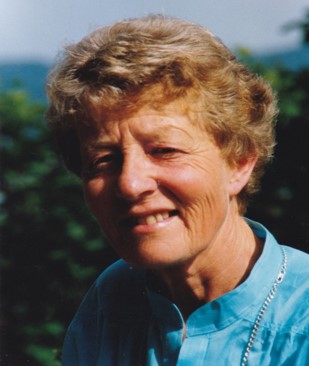
A memorial for Kathie Strickland is to be held at Coolart Wetlands and Homestead 11am Thursday 14th November 2019. Kathie and Peter Strickland wrote and illustrated Plants of The Mornington Peninsula and founded and ran an indigenous Plant nursery. They did management plans for areas including Balnarring Foreshore and Emu Plains. Please bring a cup and chair. We will be in the observatory or Stables if the weather is unsuitable.
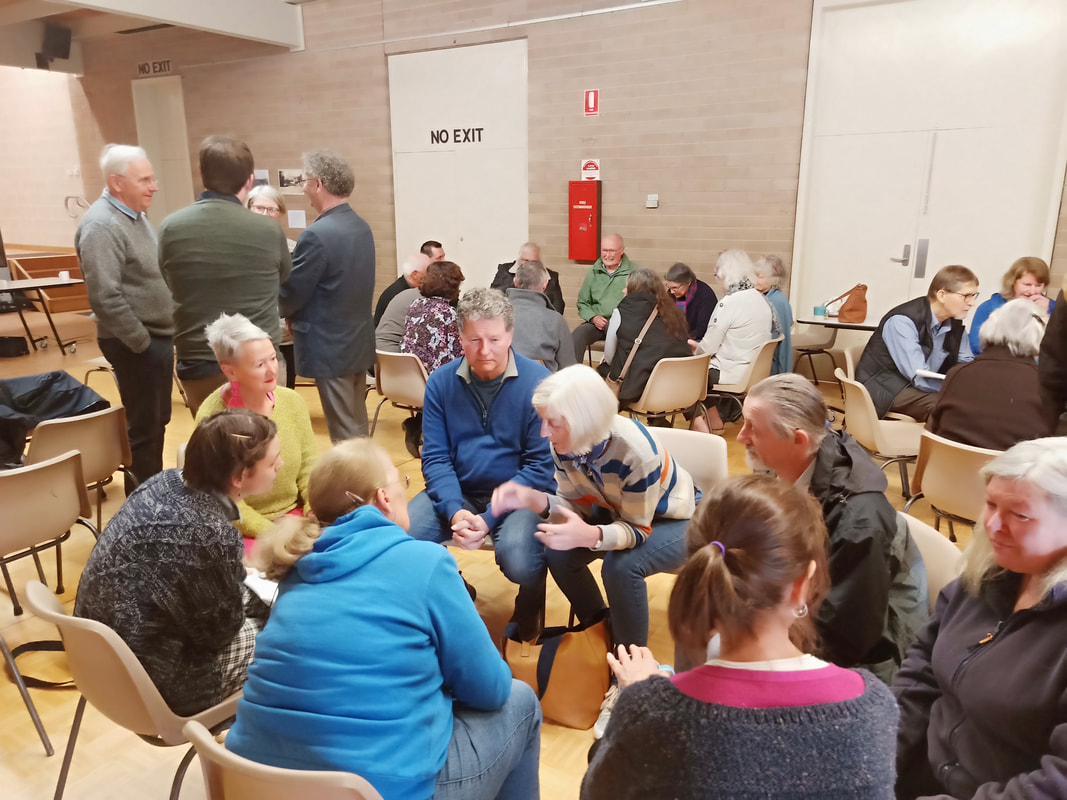
Towards clean energy in Western Port
On Sunday October 27, Energy Justice Victoria visited Balnarring as a third stop in their Fossil Frontlines Community Tour.
Save Westernport and Westernport and Peninsula Protection Council Inc. co-hosted the event, discussing Westernport’s unique, world heritage listed environment and the risks posed by fossil fuel-based development. The Hastings Kawasaki export plant trial, producing hydrogen from brown coal, and AGL’s proposed floating gas station at Crib Point pose environmental threats to the people, economy and environmental health of Westernport.
Crib Point Action Group spoke to the Crib Point Community Action Plan.
La Trobe Community Power Hub, Environment Victoria and Friends of the Earth discussed the work of other communities who have sought and/or established clean and sustainable local alternatives to fossil fuel.
Balnarring Hall was buzzing with ideas from community members, who spoke of their frustration at expensive and unsustainable projects and concerns for the health and environmental impacts of further industrialisation of the bay.
People were excited to discuss alternatives, including removal of abandoned BP silos and local land rejuvenation at Crib Point, community power options, fostering further ecotourism, environmental education and protecting important ecosystems in the Westernport catchment, that impact the bay.
The workshop was an enthusiastic, proactive step towards a more sustainable Westernport that we hope will continue to generate community input and support. Watch this space!
For more information about the FOE Fossil Fuels tour: https://www.melbournefoe.org.au/fossil_frontlines
https://www.melbournefoe.org.au/_busting_victoria_s_gas_myths
For information on Save Westernport and WPPC:
https://www.wppcinc.org/ or https://savewesternport.org/
Local contacts:
[email protected] or https://savewesternport.org/contact/
Fossil Frontlines Community Tour - Westernport
BY KATE WATTCHOW ON NOVEMBER 01, 2019
On Sunday the 27th of October, members of Energy Justice Victoria (EJV) visited Westernport Bay for the third week of the Fossil Frontlines Community Tour. EJV co-hosted a community meeting with local groups Save Westernport and Westernport and Peninsula Protection Council in the vibrant Balnarring township.
Westernport Bay is home to an internationally recognised biosphere, featuring mangroves and Ramsar-listed wetlands (both of which are becoming increasingly recognised for their natural carbon-capture capacity), as well as migration paths for various whale species.
The proposed AGL gas plant seeks to import frozen gas on ships moored at Crib Point in Western Port in a misguided attempt to prop up Australia’s broken gas market. Were AGL’s project to go ahead, seawater would be drawn from the ocean onto the floating offshore plant to heat the gas, spewing out chlorinated water waste at a cooler temperature. To achieve this, AGL is pressuring the EPA to loosen water regulations. Gas resulting from the dubious process would be transported through areas with significant biodiversity and bushfire risk, as well as through important farmland that forms part of Melbourne’s food bowl.
Additionally, Kawasaki's hydrogen export station is seen by many as an unwelcome attempt to further industrialise the bay.
Representatives from the hosting groups as well as from the Crib Point Action Group, the Latrobe Valley Community Power Hub and Environment Victoria spoke on two major proposed fossil fuel projects currently affecting the area: a proposed hydrogen export station, part of the Hydrogen Energy Supply Chain project attached to Kawasaki’s coal-to-hydrogen project, and AGL’s proposed floating gas station.
Kate from Energy Justice Victoria provided an update on the Fossil Frontlines Community Tour, as well as a brief overview of Victoria's broken gas market.
Chris Barfoot from the Latrobe Valley Community Power Hub offered a bevy of options for a more positive energy future. A third-generation former coal worker in a traditionally coal-heavy industrial area, Barfoot is convinced the industry is a ‘dinosaur’ kept alive by myopic state and federal government policy. He shared opportunities presented by community projects that can viably replace gas and coal for heating, energy, and industry employment.
Dale from the Crib Point Action Group outlined how local communities instead demand part of the formerly BHP-owned land, now languishing and disused, be rezoned and rehabilitated.
Julia from SaveWesternport and Adele from Environment Victoria’s campaign to stop AGL spoke about the unique environment and biodiversity of the region, threatened by industry and government’s failure to remain accountable to community concerns surrounding the projects.
Both the heating and transportation process for the imported gas have met with significant concern from the community, outlined by Karri from the Westernport and Peninsula Protection Council.
After the speakers, local community members broke into groups to discuss their particular concerns. With so many in attendance, discussion was diverse and wide-ranging. Common topics centred around marine life such as: unclear impacts of frozen gas heated offshore, spewing cold water into an ocean that has recently seen increased activity from whales and dolphins; threats to the unique mangroves that protect the beach from erosion; and the risk of invasive marine species entering the bay on ships transporting gas to the offshore AGL plant.
Yet locals also expressed hope for a positive energy future. Opportunities presented by the Latrobe Valley Community Power Hub inspired visions for similar projects in Westernport Bay, as well as ways to strengthen already-existent economies in ecotourism and sustainable marine farming. Better uses of government funding and policy power also included possible projects like walkways along the unique shoreline and Ramsar wetlands to support all-abilities bushwalking and bird-watching, and low-impact watersport clubs for locals and tourists.
Those present expressed how their fight for energy justice was united with those against extractive industry in Ninety Mile Beach and Seaspray, where EJV has visited over the past weeks. The message to vested interest behind AGL and Kawasaki was clear: there is no social licence for government and industry to prop up short-term extractivism that only benefits big business. Local communities and workers deserve just transition to renewable energy, ecotourism and regenerative farming.
ACT NOW:
The next stop on EVJ’s listening tour will in Latrobe Valley with community group A New Power, on Sunday the 3rd of November. You can follow and RSVP here
You can also learn more about Friends of the Earth Melbourne and EJV’s work opposing new fossil fuels in Victoria here
Energy Justice Victoria's work with frontline communities is made possible by generous donors. We are walking in Friends of the Earth Melbourne's annual Walk This Way fundraiser; you can make a tax-deductable donation here
Do you like this post?
Friends of the Earth acknowledge that we meet and work on the land of the Wurundjeri people and that sovereignty of the land of the Kulin Nation were never ceded. We pay respect to their Elders, past and present, and acknowledge the pivotal role that Aboriginal and Torres Strait Islander people continue to play within the Australian community.
To see Energy Justice's Blog from the Fossil Frontlines event Westernport click on the link below
https://www.melbournefoe.org.au/fossil_frontlines_westernport
https://www.melbournefoe.org.au/fossil_frontlines_westernport

Attention: WE ARE FACING A CLIMATE CRISIS!
Save Westernport & WPPC
are hosting
Energy Justice Victoria & FoE (Friends of the Earth)
as they tour Victoria and campaign for
A just transition from fossil fuels…
Sunday 27 October, 2pm-3:30 pm
Balnarring Hall
Program:
Speakers including; Save Westernport
Kate Wattchow from Friends of the Earth
Karri Giles Westernport & Peninsula Protection Council
Adele Neale from Environment Victoria
Chris Barfoot from LaTrobe Community Power Hub
Other activities:
Video
Breakout groups
Developing a Community Strategy
Join the community discussion about alternate, positive visions beyond fossil fuelsCopyright © 2019 Westernport and Peninsula Protection Council, All rights reserved.
Save Westernport & WPPC
are hosting
Energy Justice Victoria & FoE (Friends of the Earth)
as they tour Victoria and campaign for
A just transition from fossil fuels…
Sunday 27 October, 2pm-3:30 pm
Balnarring Hall
Program:
Speakers including; Save Westernport
Kate Wattchow from Friends of the Earth
Karri Giles Westernport & Peninsula Protection Council
Adele Neale from Environment Victoria
Chris Barfoot from LaTrobe Community Power Hub
Other activities:
Video
Breakout groups
Developing a Community Strategy
Join the community discussion about alternate, positive visions beyond fossil fuelsCopyright © 2019 Westernport and Peninsula Protection Council, All rights reserved.
They used part of our press release
https://www.nationaltribune.com.au/hydrogen-trial-to-nowhere-mr-andrews/
https://www.nationaltribune.com.au/hydrogen-trial-to-nowhere-mr-andrews/
|
|
18/7/2019 Press Release - A Trial to Nowhere Mr Andrews?
Eight Environment groups Protest Against the Sod-Turning Event for the Kawasaki/ Government Hydrogen Export Pilot in Hastings, being the Launch of Hydrogen Industry in Australia.
There is an ACTION: 10am- 12pm Friday 19th July 2019 Marine Parade Hastings Cnr Graydens Rd
A trial to burn brown coal from Victoria's Latrobe Valley into liquid hydrogen, then export it to Japan from Hastings, is set to begin. People representing eight environmental groups; that have signed a letter asking for marine pest monitoring at Bluescope as part of The Hydrogen Export Trial and the cessation of the entire project, will conduct a peaceful protest. The open letter is to The Federal and State Governments, and to Kawasaki, as leader of the consortium of Japanese companies behind the project, (including J Power and Iwatani). The eight environmental groups include Westernport and Peninsula Protection Council, Save Westernport, Blue Wedges, Friends of The Earth, Victorian National Parks Association, Environment Victoria, Preserve Westernport and Southern Peninsula Indigenous Flora and Fauna Association.
“Tomorrow we stand together again to protect Westernport Bay. If the full-scale project is too damaging, expensive and inefficient to go ahead then, there is no need for this trial they are celebrating today. As they turn the sod, we say Sod-Off! “Karri Giles Secretary WPPC
“This Trial would put Westernport Bay at immediate risk from the introduction of marine pests. Empty ships arriving to take on cargo are weighted with ballast water that, along with the hulls, could be contaminated with invasive species. We know the release of Northern Pacific Seastar from Japanese woodchip ships led to infestations of the temperate woodchip ports of Port Phillip Bay and Tasmania’s Derwent estuary. This invasive species has caused irreversible effects to these waters and their fisheries. We do not want Northern Pacific sea-star in Westernport Bay. In its current healthy state the Bay is estimated to be worth billions of dollars every year, and is much too precious to risk. We demand the site is monitored for at least four years for marine pests.” Karri Giles
“Over one million tourists visit Phillip Island each year and they do not come to see an industrial waterway. Heavy industries and eco tourism do not co exist and the Phillip Island recognises that the environment is our economy." Jeff Nottle President Phillip Island Conservation Society
“We trust that it will never proceed because the necessary dredging in Hastings is unconscionable. Infrastructure Victoria ruled out Westernport Bay as an option for a container port because of the necessary 23 million cubic metres of dredging. As the waters of Westernport Bay take up an area of 680 square kilometres, this is the equivalent of digging up the entire Bay to a depth of 3.4m (house ceiling height). Seagrass could not grow to the new depths required, leading to ongoing erosion in our fast tides, creating turbidity and death by seabed suffocation and coastal inundation.” Karri Giles (Ref: Infrastructure Victoria Container Port Discussion Paper)
Eight groups endorsed Bass Coast Shire Council’s Principle: No capital dredging in Westernport Bay. Westernport Bay cannot host a new port for commercial-scale ships, Northern Westernport is too shallow. The hydrogen gas ships for the long-term proposal are of deep draught.
Threatens 90 Mile Beach Area: Sequestering sounds green, but hasn’t been tried, hasn’t been costed, and has risks. Ninety Mile Against Carbon Storage and Friends of The Earth are a group opposing it. Latrobe Valley and the region deserve a sustainable job creation boost, not one that is likely to be another failed project.
“This project is entirely dependent on the successful injection and long term storage of carbon waste into the Ninety Mile Beach seabed, yet despite billions of dollars of investment in this technology it has failed to become viable in Australia,” campaigns coordinator Cam Walker from Friends of the Earth said.
“Kawasaki’s brown coal project is yet another clean coal pipe-dream, a false-promise to the Latrobe Valley community and an expensive distraction in a time when we need urgent action on climate change,” Friends of the Earth coal spokesperson Kate Wattchow said.
“Four industrial processes and three journeys make this project ridiculously inefficient, when apparently making hydrogen in Japan out of water and excess renewables is an option.” Karri Giles (source Solar Quotes)
The Federal and State Governments have contributed 50 Million dollars each for this trial alone and Japan, 400 million. This doesn’t include the cost of determining how to inject the coal waste into the ground and building pipes to the 90 Mile Beach. An extra $100 million has been given to CarbonNet, who are leading the proposed carbon-waste injection project. Tax payer’s money could have been spent on sustainable, long-term power projects.
“The last thing we should be embarking on in Westernport is another inappropriate outdated fossil fuels project that would threaten our remaining coastal ecosystems. Mangrove beds are our first line defence against coastal inundation and the impacts of climate change. Westernport has many supporters who understand the significance of the bay’s Biosphere and Ramsar wetlands and we will fight to protect them. We believe the launch of the hydrogen industry in Australia deserves a more worthy project. We are disappointed to learn that the trial is commencing with absolutely no public consultation, or input from Mornington Peninsula Shire Council. Wynne labelled it an ‘Essential Service’ which it isn’t; it is a trial to nowhere. We question the sense of doing a trial for such a flawed project.” Julia Stockigt Save Westernport
We call for our governments to suspend the 100 million dollars spend on this trial. It is redundant, because the full-scale commercial project cannot go ahead, it is too damaging, expensive and inefficient.
Fig 1. We are happy to have the chance to pass on the award for the stupidest idea of 2018 to representatives of Daniel Andrew and Malcolm Turnbull. This was for Hydrogen out of Brown coal, exported from Hastings. We announced that they won at the Rally with Save Westernport, Blue Wedges, Friends of The Earth, VNPA and Environment Victoria and SPIFFA July 2018 at Hastings Foreshore.
Fig 2. Northern Pacific Seastar
Westernport and Peninsula Protection Council Inc. (wppcinc.org) Karri Giles - 0425 707 448
Julia Stockigt – Save Westernport - 0457 320 234 home (03) 59 830 094
For government advice on Marine Pests the relevant authority is Parks Vic Program Leader Marine and Coasts. Invasive Species Officer – Marine – Mr Mark Rodrigue – 03 842 72840 (not part of this group)
18/7/2019 Press Release - A Trial to Nowhere Mr Andrews?
Eight Environment groups Protest Against the Sod-Turning Event for the Kawasaki/ Government Hydrogen Export Pilot in Hastings, being the Launch of Hydrogen Industry in Australia.
There is an ACTION: 10am- 12pm Friday 19th July 2019 Marine Parade Hastings Cnr Graydens Rd
A trial to burn brown coal from Victoria's Latrobe Valley into liquid hydrogen, then export it to Japan from Hastings, is set to begin. People representing eight environmental groups; that have signed a letter asking for marine pest monitoring at Bluescope as part of The Hydrogen Export Trial and the cessation of the entire project, will conduct a peaceful protest. The open letter is to The Federal and State Governments, and to Kawasaki, as leader of the consortium of Japanese companies behind the project, (including J Power and Iwatani). The eight environmental groups include Westernport and Peninsula Protection Council, Save Westernport, Blue Wedges, Friends of The Earth, Victorian National Parks Association, Environment Victoria, Preserve Westernport and Southern Peninsula Indigenous Flora and Fauna Association.
“Tomorrow we stand together again to protect Westernport Bay. If the full-scale project is too damaging, expensive and inefficient to go ahead then, there is no need for this trial they are celebrating today. As they turn the sod, we say Sod-Off! “Karri Giles Secretary WPPC
“This Trial would put Westernport Bay at immediate risk from the introduction of marine pests. Empty ships arriving to take on cargo are weighted with ballast water that, along with the hulls, could be contaminated with invasive species. We know the release of Northern Pacific Seastar from Japanese woodchip ships led to infestations of the temperate woodchip ports of Port Phillip Bay and Tasmania’s Derwent estuary. This invasive species has caused irreversible effects to these waters and their fisheries. We do not want Northern Pacific sea-star in Westernport Bay. In its current healthy state the Bay is estimated to be worth billions of dollars every year, and is much too precious to risk. We demand the site is monitored for at least four years for marine pests.” Karri Giles
“Over one million tourists visit Phillip Island each year and they do not come to see an industrial waterway. Heavy industries and eco tourism do not co exist and the Phillip Island recognises that the environment is our economy." Jeff Nottle President Phillip Island Conservation Society
“We trust that it will never proceed because the necessary dredging in Hastings is unconscionable. Infrastructure Victoria ruled out Westernport Bay as an option for a container port because of the necessary 23 million cubic metres of dredging. As the waters of Westernport Bay take up an area of 680 square kilometres, this is the equivalent of digging up the entire Bay to a depth of 3.4m (house ceiling height). Seagrass could not grow to the new depths required, leading to ongoing erosion in our fast tides, creating turbidity and death by seabed suffocation and coastal inundation.” Karri Giles (Ref: Infrastructure Victoria Container Port Discussion Paper)
Eight groups endorsed Bass Coast Shire Council’s Principle: No capital dredging in Westernport Bay. Westernport Bay cannot host a new port for commercial-scale ships, Northern Westernport is too shallow. The hydrogen gas ships for the long-term proposal are of deep draught.
Threatens 90 Mile Beach Area: Sequestering sounds green, but hasn’t been tried, hasn’t been costed, and has risks. Ninety Mile Against Carbon Storage and Friends of The Earth are a group opposing it. Latrobe Valley and the region deserve a sustainable job creation boost, not one that is likely to be another failed project.
“This project is entirely dependent on the successful injection and long term storage of carbon waste into the Ninety Mile Beach seabed, yet despite billions of dollars of investment in this technology it has failed to become viable in Australia,” campaigns coordinator Cam Walker from Friends of the Earth said.
“Kawasaki’s brown coal project is yet another clean coal pipe-dream, a false-promise to the Latrobe Valley community and an expensive distraction in a time when we need urgent action on climate change,” Friends of the Earth coal spokesperson Kate Wattchow said.
“Four industrial processes and three journeys make this project ridiculously inefficient, when apparently making hydrogen in Japan out of water and excess renewables is an option.” Karri Giles (source Solar Quotes)
The Federal and State Governments have contributed 50 Million dollars each for this trial alone and Japan, 400 million. This doesn’t include the cost of determining how to inject the coal waste into the ground and building pipes to the 90 Mile Beach. An extra $100 million has been given to CarbonNet, who are leading the proposed carbon-waste injection project. Tax payer’s money could have been spent on sustainable, long-term power projects.
“The last thing we should be embarking on in Westernport is another inappropriate outdated fossil fuels project that would threaten our remaining coastal ecosystems. Mangrove beds are our first line defence against coastal inundation and the impacts of climate change. Westernport has many supporters who understand the significance of the bay’s Biosphere and Ramsar wetlands and we will fight to protect them. We believe the launch of the hydrogen industry in Australia deserves a more worthy project. We are disappointed to learn that the trial is commencing with absolutely no public consultation, or input from Mornington Peninsula Shire Council. Wynne labelled it an ‘Essential Service’ which it isn’t; it is a trial to nowhere. We question the sense of doing a trial for such a flawed project.” Julia Stockigt Save Westernport
We call for our governments to suspend the 100 million dollars spend on this trial. It is redundant, because the full-scale commercial project cannot go ahead, it is too damaging, expensive and inefficient.
Fig 1. We are happy to have the chance to pass on the award for the stupidest idea of 2018 to representatives of Daniel Andrew and Malcolm Turnbull. This was for Hydrogen out of Brown coal, exported from Hastings. We announced that they won at the Rally with Save Westernport, Blue Wedges, Friends of The Earth, VNPA and Environment Victoria and SPIFFA July 2018 at Hastings Foreshore.
Fig 2. Northern Pacific Seastar
Westernport and Peninsula Protection Council Inc. (wppcinc.org) Karri Giles - 0425 707 448
Julia Stockigt – Save Westernport - 0457 320 234 home (03) 59 830 094
For government advice on Marine Pests the relevant authority is Parks Vic Program Leader Marine and Coasts. Invasive Species Officer – Marine – Mr Mark Rodrigue – 03 842 72840 (not part of this group)
There is a free Bus to go up to Melbourne next Wednesday JUN12 from Hastings to give the petition to the AGL CEO in Melbourne
· It is Hosted by Save Westernport No AGL gas
Wednesday at 8 AM – 12:30 PM
· It is Hosted by Save Westernport No AGL gas
Wednesday at 8 AM – 12:30 PM
- Westernport Marina
Mullet Street, Hastings, Victoria 3915
Show Map - Tickets by Eventbrite
- RSVP
The bus trip is free but donations toward the cost via our w... More
Sales end on Jun 11 at 7 PM
Free
- RSVP
Vale Sheila KerIt is with deep sadness that we announce the death of Sheila Ker.
Sheila was one of the hardest working members of WPPC ever. She joined when we were opposing the proposed container port and showed passion, initiative and grit. Her husband Russell and she leafletted people on the beaches and boat ramps, they build the stage that was used for rallys, and opened their home for meetings and banner painting. She served on the committee for ten years working very hard as Treasurer. Her daughter Vanessa designed our tea-towels. She was passionate about Westernport and extremely pleasant and warm. We will miss her and her noodle salad. It was great that she could go to the Biggest Paddle out in January and see one thousand people come out to support her beloved Westernport. Funeral 4.30pm Friday 7th June 2019 Stratus Room Bunerong Memorial Park Frankston-Dandenong Rd Dandenong South |
1st May 520 people gathered at Balnarring Hall to protect Westernport. There were twice as many at the paddle out, 320 at the last public meeting. 400 at the July 1st rally last year. The gas import plan for AGL and the Kawasaki Hydrogen export project do not have social license. Thank you to all candidates for opposing the AGL plan, especially Nathan Leslie Greens, Greg Hunt Liberal, Sue Beveridge, Josh Sinclair Labor, Julia Banks, and Reid Smith Sustainable Australia for outlining action you have taken or would take to stand against this proposal.
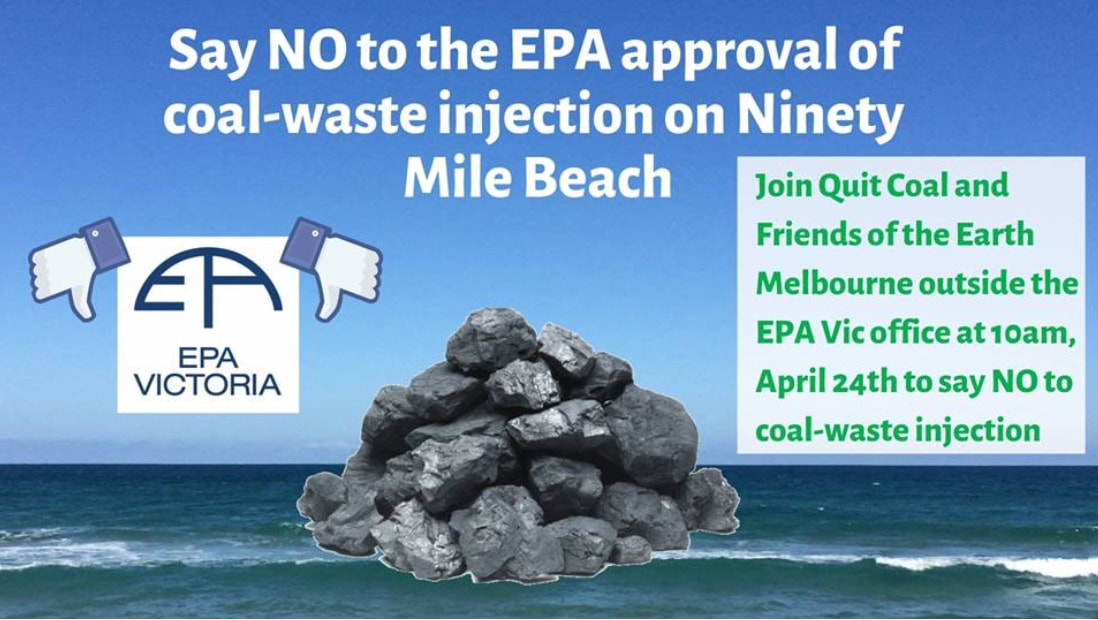
Join WPPC in an protest in the city
tomorrow Wednesday 24th April
to protect Westernport Bay from a Hydrogen Export Port
What: An ACTION against the Kawasaki proposal to burn Brown Coal to produce Hydrogen,
sequester the waste water at the Ninety Mile Beach
and Export Hydrogen at a new port at Hastings
When: Wed April 24 at 10am
Where: EPA office. 200 Victoria St Carlton.
Who: Friends of the Earth, Quit Coal, WPPC, Ninety Mile Beach Residents and you.
Why: The EPA is supposed to protect Victoria and Victorians from the harms of industry. We know that Burning Brown Coal is dangerous and unnecessary
Kawasaki plans to use the Port of Hastings to ship the H2 to Japan. A recent meeting at the Port heard that construction of the pilot H2 storage depot “will begin in June”.
https://www.melbournefoe.org.au/no_coal_waste_injection_on_ninety_mile_beach
regards
Karri and Julia
WPPCinc
tomorrow Wednesday 24th April
to protect Westernport Bay from a Hydrogen Export Port
What: An ACTION against the Kawasaki proposal to burn Brown Coal to produce Hydrogen,
sequester the waste water at the Ninety Mile Beach
and Export Hydrogen at a new port at Hastings
When: Wed April 24 at 10am
Where: EPA office. 200 Victoria St Carlton.
Who: Friends of the Earth, Quit Coal, WPPC, Ninety Mile Beach Residents and you.
Why: The EPA is supposed to protect Victoria and Victorians from the harms of industry. We know that Burning Brown Coal is dangerous and unnecessary
Kawasaki plans to use the Port of Hastings to ship the H2 to Japan. A recent meeting at the Port heard that construction of the pilot H2 storage depot “will begin in June”.
https://www.melbournefoe.org.au/no_coal_waste_injection_on_ninety_mile_beach
regards
Karri and Julia
WPPCinc
Come and give your opinion to AGL
| agl__drop_in_sess.docx |
WPPC Host A Screening
Rosebud Cinema
6pm 23rd February 2019
The Bentley Effect
Buy Tickets now!- Scroll down- Only available online
Westernport and Peninsula Protection Council is hosting a screening of The Bentley Effect; a multi-award winning, PG-rated documentary about t,he community of The Northern Rivers Shire Standing up against a Fracking company, over 5 years. Please buy tickets below now as they the more people buying soon, the bigger the cinema we get. Tickets are only available online. It should be a great night out, with an update of our Westernport Campaign.
| 20170905-be_poster_eventbrite.pdf |
WPPC’s AGM Balnarring Hall
3041 Frankston- Flinders Road Balnarring
Sunday 13th January 2019 10.30am
All welcome- Please RSVP for lunch to [email protected]
Guest Speakers: Louise Page and Dale Stohr
Spokespeople from Save Westernport
Community Concerns about the proposed
AGL Gas Import Terminal and Pipeline
There will also be a summary by WPPC of the Kawasaki Hydrogen Project.
3041 Frankston- Flinders Road Balnarring
Sunday 13th January 2019 10.30am
All welcome- Please RSVP for lunch to [email protected]
Guest Speakers: Louise Page and Dale Stohr
Spokespeople from Save Westernport
Community Concerns about the proposed
AGL Gas Import Terminal and Pipeline
There will also be a summary by WPPC of the Kawasaki Hydrogen Project.
| wppc_hydrogen_hastings_form_letter.doc |
| biggest_paddle.docx |
| biggest_paddle.docx |
|
Rally 1 pm Sunday 1st July 2018
One Rally two threats Threat one AGL Gas imports at Crib Point Threat 2 Hydrogen Gas exports from Hastings Fred Smith Reserve Hastings Foreshore Family Friendly, Peaceful, Hear Speeches, Take action |
| ||
Two threats in Westernport, one being the:
Hydrogen Project at Hastings -
A demonstration plant will be built in the Latrobe Valley as part of the $496 million project to develop technology to produce hydrogen from the region's reserves of coal.
The hydrogen would be shipped from the Port of Hastings to Japan under the deal with Kawasaki Heavy Industries, J-Power, Iwatani Corporation, Marubeni and the Japanese Government. Hastings is too shallow to be a port for big modern ships. The necessary dredging is what ruled out Hastings from being considered as a container port by Infrastructure Victoria. 23 million cubic metres of dredging is the same amount as Port Phillip Bay's channel deepening and Westernport Bay has ten times less capacity than Port Phillip Bay.
The Federal and Victorian Governments are providing $100 million towards the cost of the trial.
and another;
AGL Floating LNG Gas Terminal at Crib Point - AGL gas terminal would provide few jobs and will cause serious air, light, noise and water pollution, present fire hazards and negatively impact property values.
Both of these industrial developments in Westernport are unsuitable. Once again is you can contact your local representatives to voice your concerns we would appreciate it. Here are the links;
Write, Phone & Email your local representatives in Local, Victorian and Federal Government;
Mornington Peninsula Shire Council
Bass Coast Shire Council
Brian Paynter - Member for Bass
Jordan Crugnale - Labor for Bass
Neil Burgess - Member for Hastings
Greg Hunt - Federal Minister for Flinders
There are a number of community groups forming on either side of Westernport to guard against Industrialisation. There are also a number of community forums being advertised in local newspapers for those who wish to go along and ask questions. It is important to let your elected representatives know that Westernport is worth preserving for future generations.
Many thanks to Preserve Westernport Action Group for this excellent summary
Hydrogen Project at Hastings -
A demonstration plant will be built in the Latrobe Valley as part of the $496 million project to develop technology to produce hydrogen from the region's reserves of coal.
The hydrogen would be shipped from the Port of Hastings to Japan under the deal with Kawasaki Heavy Industries, J-Power, Iwatani Corporation, Marubeni and the Japanese Government. Hastings is too shallow to be a port for big modern ships. The necessary dredging is what ruled out Hastings from being considered as a container port by Infrastructure Victoria. 23 million cubic metres of dredging is the same amount as Port Phillip Bay's channel deepening and Westernport Bay has ten times less capacity than Port Phillip Bay.
The Federal and Victorian Governments are providing $100 million towards the cost of the trial.
and another;
AGL Floating LNG Gas Terminal at Crib Point - AGL gas terminal would provide few jobs and will cause serious air, light, noise and water pollution, present fire hazards and negatively impact property values.
Both of these industrial developments in Westernport are unsuitable. Once again is you can contact your local representatives to voice your concerns we would appreciate it. Here are the links;
Write, Phone & Email your local representatives in Local, Victorian and Federal Government;
Mornington Peninsula Shire Council
Bass Coast Shire Council
Brian Paynter - Member for Bass
Jordan Crugnale - Labor for Bass
Neil Burgess - Member for Hastings
Greg Hunt - Federal Minister for Flinders
There are a number of community groups forming on either side of Westernport to guard against Industrialisation. There are also a number of community forums being advertised in local newspapers for those who wish to go along and ask questions. It is important to let your elected representatives know that Westernport is worth preserving for future generations.
Many thanks to Preserve Westernport Action Group for this excellent summary
| rally_media_release_20june2018.docx |
|
Hon Lily D'Ambrosio
Level 16 8 Nicholson Street
East Melbourne Vic 3002
Saturday 14th October 2017
Save Westernport’s Fish stocks
Say No to Kawasaki at Hastings
Kawasaki, J Power and Iwatani have proposed to export hydrogen gas made from Loy Yang’s brown coal that has been partially burnt. There are three industrial processes, trucking of gas to Hastings, and a ship journey to Japan involved. That makes this hydrogen one of the least efficient power sources ever dreamt up, and certainly one of the most expensive. The fact they “are looking for a partnership with the Victorian Government” means they want this exercise in wrecking Westernport Bay to be subsidised.
The dredging involved with bringing very large ships into Hastings would be massive. Infrastructure Victoria said it would take 23 million cubic metres inside and the same outside Westernport for container ships. The fact the ships are empty and require ballast means marine pests. i.e. The Northern Pacific Star Fish. This starfish came into Corio Bay in the ballast of Japanese woodchip ships and has been partially responsible for the decimating of fish stocks in Port Phillip Bay. Westernport Bay currently does not have Northern Pacific Sea Star.
Gas trucks on our road to Hastings and the burning of brown coal are also steps backwards.
We urge you, Hon Lily Ambrosio to say no to this proposal.
Yours sincerely,
...................................................................
....................................................................
Level 16 8 Nicholson Street
East Melbourne Vic 3002
Saturday 14th October 2017
Save Westernport’s Fish stocks
Say No to Kawasaki at Hastings
Kawasaki, J Power and Iwatani have proposed to export hydrogen gas made from Loy Yang’s brown coal that has been partially burnt. There are three industrial processes, trucking of gas to Hastings, and a ship journey to Japan involved. That makes this hydrogen one of the least efficient power sources ever dreamt up, and certainly one of the most expensive. The fact they “are looking for a partnership with the Victorian Government” means they want this exercise in wrecking Westernport Bay to be subsidised.
The dredging involved with bringing very large ships into Hastings would be massive. Infrastructure Victoria said it would take 23 million cubic metres inside and the same outside Westernport for container ships. The fact the ships are empty and require ballast means marine pests. i.e. The Northern Pacific Star Fish. This starfish came into Corio Bay in the ballast of Japanese woodchip ships and has been partially responsible for the decimating of fish stocks in Port Phillip Bay. Westernport Bay currently does not have Northern Pacific Sea Star.
Gas trucks on our road to Hastings and the burning of brown coal are also steps backwards.
We urge you, Hon Lily Ambrosio to say no to this proposal.
Yours sincerely,
...................................................................
....................................................................
The reason we are against an increase in shipping in Westernport |
Every ship has the capacity to bring in marine pests. AGL gas ship will be coming from ports that are infested with marine pests. They will not be coming with ballast water though as they will be fully loaded this minimises the risk of marine pests.
AGL ships are run from cooled liquid gas. This is so cold no human could be near a spill until all the liquid gas has spilt and warmed up, so the entire load would be spilt. This creates a hydrocarbon vapour cloud that could fuel a fire if exposed to naked flame, or if it is raining, end up in our precious Bay. The waters of Westernport are very shallow and some areas like Mchaffies Reef are rocky. The channel is very narrow. The tides are very strong. AGL ships are 260m long making running aground a real possibility. Most sailors in Westernport Bay have run aground. |
One of the industrial processes required is to run sea water around the gas to warm it; cooling the seawater by 6 degrees. This may be the death knell for local mangroves because they are temperature sensitive. Cooler temperatures may affect other species too that rely on seasonal changes to trigger their life cycles. The Bay gets soupy in Summer so cooler temperatures would have a beneficial effect in some ways at least. AGL promised to staff their ships with Australian crews. Will they keep to that? International shipping companies are notoriously dodgy. We want Australian jobs. |
8th March 2017
“Infrastructure Victoria has yesterday presented its paper on a potential second container port for Melbourne. We have finally got a dredging estimate for the proposed port of Hastings: 47 million cubic metres is more than double Port Phillip Bay’s infamous channel deepening. Westernport Bay’s seagrass holds down the sediment in many places, and grows only at specific depths. Our deep-growing seagrass Amphibolis antartica just would never grow at 18 metres deep, unless the water was clear and non polluted. Re-sedimentation would turn Westernport permanently muddy.
See IUCN research below.
http://www.iucnredlist.org/details/173356/0
Ecology:
Amphibolis antarctica is a seagrass that dominates (with Posidonia australis) the subtidal environment in western and southern Australia, in sandy lower-littoral pools and channels, to depths of about 12 m. In southeastern Australia, it forms patches of varying sizes at the mouth of some bays, and occurs in areas dominated by sandy siliceous sediments and exposed to ocean swells. It can be present to depths of 22 m in clear non-polluted water. It is a slow-growing seagrass
Bass Coast Shire and nine environmental groups have called for a ban on capital dredging. See attached letter.
Infrastructure Victoria thinks the main reason to build a second container port is in case retailers want to bring in goods in the world’s second biggest ships. Most right thinking people here would rather the ships fit the port than build a whole new port to take bigger ships. “
Regards
Karri Giles
Secretary
Westernport Peninsula Protection Council
“Infrastructure Victoria has yesterday presented its paper on a potential second container port for Melbourne. We have finally got a dredging estimate for the proposed port of Hastings: 47 million cubic metres is more than double Port Phillip Bay’s infamous channel deepening. Westernport Bay’s seagrass holds down the sediment in many places, and grows only at specific depths. Our deep-growing seagrass Amphibolis antartica just would never grow at 18 metres deep, unless the water was clear and non polluted. Re-sedimentation would turn Westernport permanently muddy.
See IUCN research below.
http://www.iucnredlist.org/details/173356/0
Ecology:
Amphibolis antarctica is a seagrass that dominates (with Posidonia australis) the subtidal environment in western and southern Australia, in sandy lower-littoral pools and channels, to depths of about 12 m. In southeastern Australia, it forms patches of varying sizes at the mouth of some bays, and occurs in areas dominated by sandy siliceous sediments and exposed to ocean swells. It can be present to depths of 22 m in clear non-polluted water. It is a slow-growing seagrass
Bass Coast Shire and nine environmental groups have called for a ban on capital dredging. See attached letter.
Infrastructure Victoria thinks the main reason to build a second container port is in case retailers want to bring in goods in the world’s second biggest ships. Most right thinking people here would rather the ships fit the port than build a whole new port to take bigger ships. “
Regards
Karri Giles
Secretary
Westernport Peninsula Protection Council
WPPC AGM Sunday 15th January 2017
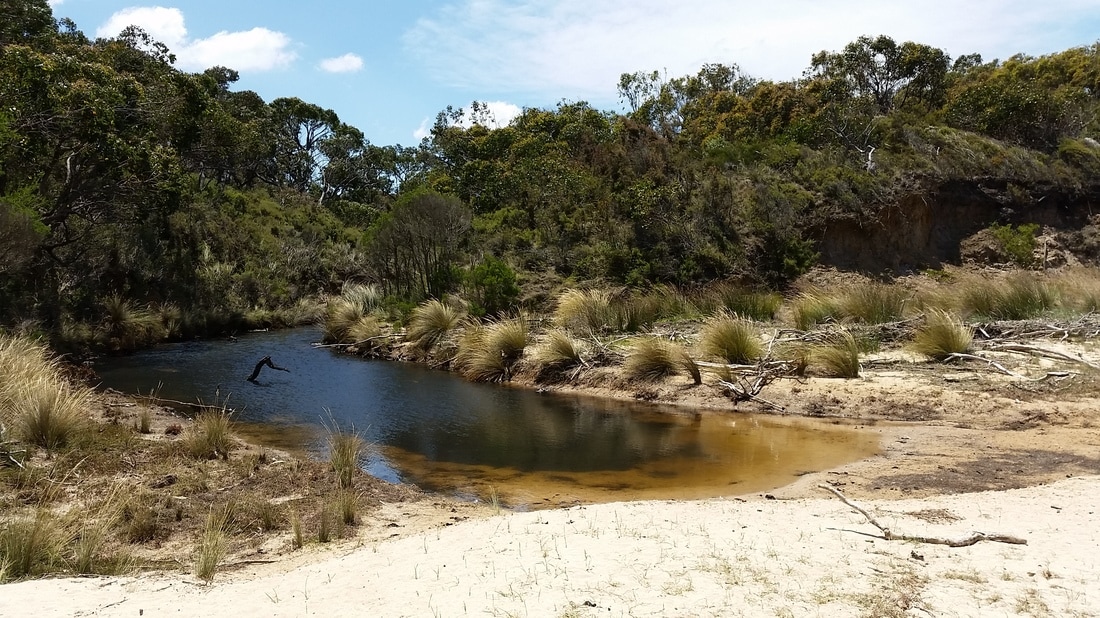
Photo: Blind Creek French Island. Chris Chandler
Friendly Reminder of AGM
Sunday 15th January 2017
at Balnarring Small Hall - 3041 Frankston- Flinders Rd Balnarring
10.30am followed by Lunch.
FOR FURTHER INFO
[email protected]
Guest Speaker: Chris Chandler Topic: French Island's Ecological Enigmas
All welcome - no RSVP necessary
Merricks Coolart Creek information on Creeks page
/creeks.html
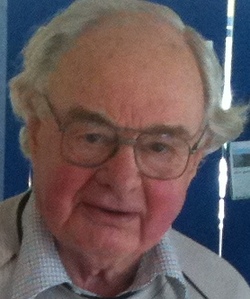
Dr Brian David Cuming OAM
Brian was awarded the Order of Australia Medal today Australia day 2015 for service to environmental Conservation in The Westernport Region.
In 1978 Dr Brian Cuming joined WPPC Committee and was involved immediately in hearings of House of Representatives Oil Spills enquiry. He learnt much from Bill Carroll, Meredith Hayes and Joe Tilleard who were very proficient leaders of the group.
In 1985 Brian Encouraged the WPPC committee to take up the battle to save BHP land for what eventually became Warringine Park, a housing development that retained its natural bush and had resources to manage it. In December of that year: Joe Tilleard died suddenly and eight months later Bill Carroll died of cancer after 15 years as President. Brian Cuming was coopted as President for the balance of year. He was elected President in 1987 and remained president until 1996, but was active on the committee until 2007. Setting the agendas for the meetings and seeing that they run well was often his responsibility, up until 2007, and then he retired from the committee and continues to contribute as a consultant. He commented extensively on the oil-spill modelling document commissioned with VNPA in 2013, and the economic study of Westernport Bay, earning the respect of the new Marine Campaigner for VNPA Simon Branigan. Brian continues an active involvement with The Devilbend Foundation.
He was involved with the proposed Western Mining urea-ammonia fertiliser plant at Crib Point; The Seagrass Events ‘88,’89,’90; The Shell-Mobil super-tanker proposal of 1992 – 1995; The Bond family port proposals at the Bluff, and subsequent Port Expansion Proposals; and many submissions .
Shortly after I joined WPPC I accompanied Brian to the community consultation workshop for The EPA’s Protecting The Waters of Westernport and Catchment. He put considerable effort into verbal and written communications before, during and after this workshop that shipping-related threats to be included in this government document, and finally they were. Just a sample of the documents Brian wrote:
Newsletters – Up until 2007 Brian wrote most of the articles in the WPPC newsletters and edited them.
Official Hansard Report Melb 19th April 1978 Pg 171-212
Submission to the House of Representatives Standing committee on Transport Communications and Infrastructure on the Inquiry on the Auditor General’s Audit Report No 9 Is Australia ready to respond to a major oil spill? August 1995 Prepared by Brian Cuming
A Fragile Ecology – Dr Brian Cuming in Enigma 1998 pg 12-12
Submission on draft Protecting The Waters of Westernport and Catchment EPA Publication
The second Iron Baron Report Implications for Westernport 10 June 1999
Letters to aid the Listing of Westernport on the National Estate Heritage Commission April 1999
1999 Westernport Bay needs a new Millennium re-think Dr Brian Cuming
WPPC Submission to Marine Coastal and Estuarine Investigation- draft Report for Public Comment co-authored with Karri Giles. March 10 2000 Addressed to Chairman Environment Conservation Council 115 Victoria Pde Fitzroy 3065
August 2000 Comments on The Victorian Ports Strategic Study co-authored with Karri Giles
Brian played many leadership roles in WPPC. He loves environmental philosophy which helped us develop the vision of our group He has shared his understanding of Rachel Carson and The Silent Spring, and “the triple bottom line”, deftly applying them to our campaign. He also shared his understanding of Gaia, James Lovelock’s theory. When he saw the Risk-Assessment Approach students were applying to the Gunnamatta campaign he grasped it and got to them to run through their ideas at one of our AGM, as it applied to WPPC. Likewise other environmental philosophy, such as The Landscape Theory of conservation, and The Edge Effect were used in the campaign to save Devilbend.
Brian fulfilled a communications role splendidly in WPPC. He was especially good at keeping people updated, networking, and finding new allies. Brian was our main contact with other environmental groups and bureaucrats for many years. He has a gift for communication and expects a longer concentration span from his listeners than most. (The problems of the world can’t be solved with glib statements). Brian appeared in the local paper and TV news with his hat on and on radio. He is responsive and timely when there is an issue.
He is broad minded. He appreciates and respects people’s endeavours in many varied fields. He even finds something to appreciate about the Melbourne Football Club’s efforts.
I will always remember at a Devilbend evening that he will describe as "magic" His son Ian had brought giant peregrine falcon puppets and Richard Cooke and other musicians were adding to the golden evening, we had giant flags to hold and we being encouraged to snake around behind each other carrying them, which was really fun. Brian was holding his backwards under his arm talking to Mark Adams, a well-known identity, and missing the fun, I mentioned this to the late Don Macmillan, and Don began tapping Brian's stick with his, Brian turned around and immediately saw it was time to stop talking. He started a vigorous play-sword fight and then joined us all in the snake.
Karri Giles
Secretary
WPPC
Brian was awarded the Order of Australia Medal today Australia day 2015 for service to environmental Conservation in The Westernport Region.
In 1978 Dr Brian Cuming joined WPPC Committee and was involved immediately in hearings of House of Representatives Oil Spills enquiry. He learnt much from Bill Carroll, Meredith Hayes and Joe Tilleard who were very proficient leaders of the group.
In 1985 Brian Encouraged the WPPC committee to take up the battle to save BHP land for what eventually became Warringine Park, a housing development that retained its natural bush and had resources to manage it. In December of that year: Joe Tilleard died suddenly and eight months later Bill Carroll died of cancer after 15 years as President. Brian Cuming was coopted as President for the balance of year. He was elected President in 1987 and remained president until 1996, but was active on the committee until 2007. Setting the agendas for the meetings and seeing that they run well was often his responsibility, up until 2007, and then he retired from the committee and continues to contribute as a consultant. He commented extensively on the oil-spill modelling document commissioned with VNPA in 2013, and the economic study of Westernport Bay, earning the respect of the new Marine Campaigner for VNPA Simon Branigan. Brian continues an active involvement with The Devilbend Foundation.
He was involved with the proposed Western Mining urea-ammonia fertiliser plant at Crib Point; The Seagrass Events ‘88,’89,’90; The Shell-Mobil super-tanker proposal of 1992 – 1995; The Bond family port proposals at the Bluff, and subsequent Port Expansion Proposals; and many submissions .
Shortly after I joined WPPC I accompanied Brian to the community consultation workshop for The EPA’s Protecting The Waters of Westernport and Catchment. He put considerable effort into verbal and written communications before, during and after this workshop that shipping-related threats to be included in this government document, and finally they were. Just a sample of the documents Brian wrote:
Newsletters – Up until 2007 Brian wrote most of the articles in the WPPC newsletters and edited them.
Official Hansard Report Melb 19th April 1978 Pg 171-212
Submission to the House of Representatives Standing committee on Transport Communications and Infrastructure on the Inquiry on the Auditor General’s Audit Report No 9 Is Australia ready to respond to a major oil spill? August 1995 Prepared by Brian Cuming
A Fragile Ecology – Dr Brian Cuming in Enigma 1998 pg 12-12
Submission on draft Protecting The Waters of Westernport and Catchment EPA Publication
The second Iron Baron Report Implications for Westernport 10 June 1999
Letters to aid the Listing of Westernport on the National Estate Heritage Commission April 1999
1999 Westernport Bay needs a new Millennium re-think Dr Brian Cuming
WPPC Submission to Marine Coastal and Estuarine Investigation- draft Report for Public Comment co-authored with Karri Giles. March 10 2000 Addressed to Chairman Environment Conservation Council 115 Victoria Pde Fitzroy 3065
August 2000 Comments on The Victorian Ports Strategic Study co-authored with Karri Giles
Brian played many leadership roles in WPPC. He loves environmental philosophy which helped us develop the vision of our group He has shared his understanding of Rachel Carson and The Silent Spring, and “the triple bottom line”, deftly applying them to our campaign. He also shared his understanding of Gaia, James Lovelock’s theory. When he saw the Risk-Assessment Approach students were applying to the Gunnamatta campaign he grasped it and got to them to run through their ideas at one of our AGM, as it applied to WPPC. Likewise other environmental philosophy, such as The Landscape Theory of conservation, and The Edge Effect were used in the campaign to save Devilbend.
Brian fulfilled a communications role splendidly in WPPC. He was especially good at keeping people updated, networking, and finding new allies. Brian was our main contact with other environmental groups and bureaucrats for many years. He has a gift for communication and expects a longer concentration span from his listeners than most. (The problems of the world can’t be solved with glib statements). Brian appeared in the local paper and TV news with his hat on and on radio. He is responsive and timely when there is an issue.
He is broad minded. He appreciates and respects people’s endeavours in many varied fields. He even finds something to appreciate about the Melbourne Football Club’s efforts.
I will always remember at a Devilbend evening that he will describe as "magic" His son Ian had brought giant peregrine falcon puppets and Richard Cooke and other musicians were adding to the golden evening, we had giant flags to hold and we being encouraged to snake around behind each other carrying them, which was really fun. Brian was holding his backwards under his arm talking to Mark Adams, a well-known identity, and missing the fun, I mentioned this to the late Don Macmillan, and Don began tapping Brian's stick with his, Brian turned around and immediately saw it was time to stop talking. He started a vigorous play-sword fight and then joined us all in the snake.
Karri Giles
Secretary
WPPC
WPPC
Westernport Scenario Workshop July 28th-August 1st 2014
What should the future of The Bass Coast Shire Be?
With planning to substantially expand the Port of Hastings into an international container port gathering momentum the future of Westernport Bay is at a crossroads.
But is this the only plausible future scenario for Westernport? Are there other scenarios that could secure both the economic and environmental future of the bay and the surrounding region?
These critically important questions will be evaluated at our upcoming workshop titled Scenario Planning for Westernport Bay, which is being led by Australian National University professor and leading ecological economist Robert Costanza, as well as Dr Ida Kubiszewski, a senior lecturer at ANU and managing editor of Solutions as well as other publications.
The workshop took place from July 28 to August 1, and has been created for business, government, environmental and social science leaders who want to help shape the future economy and ecology of the Westernport region.
It has been organised by the Australian National University, Preserve Western Port Action Group and the Victorian National Parks Association, and is supported by the Bass Coast Shire Council.
What is scenario planning?
Scenario planning is a structured process of exploring and evaluating plausible futures.
Scenario planning exercises have been conducted in Australia and internationally for a range of purposes including regional futures, corporate strategy, political transition and community-based natural resource management.
With planning to substantially expand the Port of Hastings into an international container port gathering momentum the future of Westernport Bay is at a crossroads.
But is this the only plausible future scenario for Westernport? Are there other scenarios that could secure both the economic and environmental future of the bay and the surrounding region?
These critically important questions will be evaluated at our upcoming workshop titled Scenario Planning for Westernport Bay, which is being led by Australian National University professor and leading ecological economist Robert Costanza, as well as Dr Ida Kubiszewski, a senior lecturer at ANU and managing editor of Solutions as well as other publications.
The workshop took place from July 28 to August 1, and has been created for business, government, environmental and social science leaders who want to help shape the future economy and ecology of the Westernport region.
It has been organised by the Australian National University, Preserve Western Port Action Group and the Victorian National Parks Association, and is supported by the Bass Coast Shire Council.
What is scenario planning?
Scenario planning is a structured process of exploring and evaluating plausible futures.
Scenario planning exercises have been conducted in Australia and internationally for a range of purposes including regional futures, corporate strategy, political transition and community-based natural resource management.
| westernport_port_expansion-impact_on_seagrass-mangrove-saltmarsh_final_april_10_2014.pdf |
| westernport_port_expansion-impact_on_birdlife_final_april_10_2014.pdf |
| bgr-wport-seagrass-mangrove-saltmarsh_final_april_10_2014.pdf |
Should or could Melbourne be the freight handling capital of Australia?
The Age Editorial 10th April 2014
Though the Coalition and Labor are divided on port options, the real battle is not between them. It is between Melbourne and Australia. Both parties need to make a clear choice about whether Melbourne, in 30 years, could or should be the ports and freight-handling capital of Australia or a secondary port. If Victoria wants to be No. 1, with the attendant economic benefits, then there will be some serious sacrifices.
Rather than ploughing headlong into such a major infrastructure development, and doing so on the basis of ideology or a race to be the biggest, we urge the leaders to pause and consider the impact of all this on the amenity of people who live, work and travel through these areas every day. The people of Melbourne. Put thousands more freight trucks on inner city roads and you risk destroying the amenity of this city. Similarly, is it really the best plan to have freight trains thundering through Melbourne's suburbs, 24 hours a day, so that shipping containers can get to the other side of the city?
Both the Coalition and Labor have a more important responsibility than simply touting their preferred option at this November's state election. They must articulate how the development of a major port will be for the benefit of all Victorians. Not just for the shipping companies. Not just for political point-scorers. For everyone.
The various port plans may create, or simply retain jobs, but at what cost to the people who live here? Will these benefits outweigh the huge cost in financial, environmental and social terms? Perhaps we have to concede we do not have the right natural advantages to be a major international port. It is time for the debate to focus on the broader issues, and not just Bay West versus Hastings.
Read more: http://www.theage.com.au/comment/the-age-editorial/the-battle-of-hastings-has-barely-begun-20140409-36dmc.html#ixzz2ySQhpNCGThe Battle of Hastings has barely begun. The Age Editorial Page 18.
Though the Coalition and Labor are divided on port options, the real battle is not between them. It is between Melbourne and Australia. Both parties need to make a clear choice about whether Melbourne, in 30 years, could or should be the ports and freight-handling capital of Australia or a secondary port. If Victoria wants to be No. 1, with the attendant economic benefits, then there will be some serious sacrifices.
Rather than ploughing headlong into such a major infrastructure development, and doing so on the basis of ideology or a race to be the biggest, we urge the leaders to pause and consider the impact of all this on the amenity of people who live, work and travel through these areas every day. The people of Melbourne. Put thousands more freight trucks on inner city roads and you risk destroying the amenity of this city. Similarly, is it really the best plan to have freight trains thundering through Melbourne's suburbs, 24 hours a day, so that shipping containers can get to the other side of the city?
Both the Coalition and Labor have a more important responsibility than simply touting their preferred option at this November's state election. They must articulate how the development of a major port will be for the benefit of all Victorians. Not just for the shipping companies. Not just for political point-scorers. For everyone.
The various port plans may create, or simply retain jobs, but at what cost to the people who live here? Will these benefits outweigh the huge cost in financial, environmental and social terms? Perhaps we have to concede we do not have the right natural advantages to be a major international port. It is time for the debate to focus on the broader issues, and not just Bay West versus Hastings.
Read more: http://www.theage.com.au/comment/the-age-editorial/the-battle-of-hastings-has-barely-begun-20140409-36dmc.html#ixzz2ySQhpNCGThe Battle of Hastings has barely begun. The Age Editorial Page 18.
Where will the ships come in The Age 10th April 2014
Click on The Age Article below to read Dr Brian Cuming Research Coordinator for Westernport and Peninsula Protection Council, a community group, says Westernport is uniquely vulnerable to shipping related pollution, because the ocean current flows clockwise around French Island, meaning any contaminant spreads around the entire bay. "Pollute The Bay anywhere and within days or weeks it'll be everywhere."
| flyer_westernport-a-bay-on-the-brink.pdf |
Jess Abrahams of Australian Conservation Foundation proudly launched this report on Tuesday March 4th 2014. This report is based on the work of Robert Costanza.
| estimating_the_ecosystem_service_value_of_western_port_-_acf_neas_2.pdf |
Phillip Island Conservation Society
is hosting a Western Port Forum and Public Meeting
Saturday 22nd March 7.30pm
Parish Hall Thompson Ave Cowes cnr Church St
is hosting a Western Port Forum and Public Meeting
Saturday 22nd March 7.30pm
Parish Hall Thompson Ave Cowes cnr Church St

Karri Giles President of WPPC
Robert Costanza, ecological economist ANU
and Simon Branigan VNPA
at the beautiful Somers Yacht Club 4th March 2014
Seminar
Valuing a natural Westernport Bay
What’s Westernport Bay really worth? The economics of ecosystems
A massive new port at Hastings is promoted as good
for the economy, but that’s not the full story.
The port is also a threat to the environment and
recreation – oil spills, dredging, land clearing and
thousands of more ships a year could take a
heavy toll on Westernport Bay.
Westernport provides an incredible range of
ecosystem services including treating pollutants
and providing plentiful fish stocks for fishers. It’s
also a beautiful place for people seeking respite
from busy working lives. But what is this really
worth in dollar terms?
This interesting and informative seminar will
explore the ‘natural’ value of Westernport Bay and
why it is worth more to the community than just a
shipping channel and port.
Speakers include Professor Robert Costanza, a
world leading expert in ecological economics, as well
as representatives from the Australian Conservation
Foundation’s New Economics Unit, the Victorian
National Parks Association and Westernport &
Peninsula Protection Council.
Seminar details
WHERE: Somers Yacht Club – Parklands Ave, Somers
(Google map reference http://goo.gl/OncAUv)
WHEN: Tuesday 4 March
TIME: Doors open 5.45pm, 6.15pm start, finishes 7.45pm
RSVP: Booking is essential and can be done through
our website at www.seminar.vnpa.org.au. Dinner is
available ($25 cash only), drinks at bar prices after the
seminar, but you must book in advance when you RSVP. The
full agenda is also available on our booking page.
Professor Robert Costanza
Professor Robert Costanza is regarded as the founding father
of the discipline of ecological economics. He is the author
or co-author of more than 500 scientific papers and 20
books, and repeatedly appears on lists of the world’s
most influential researchers.
He holds a Chair in Public Policy at the ANU’s Crawford
School of Public Policy.
TUESDAY 4
Valuing a natural Westernport Bay
What’s Westernport Bay really worth? The economics of ecosystems
A massive new port at Hastings is promoted as good
for the economy, but that’s not the full story.
The port is also a threat to the environment and
recreation – oil spills, dredging, land clearing and
thousands of more ships a year could take a
heavy toll on Westernport Bay.
Westernport provides an incredible range of
ecosystem services including treating pollutants
and providing plentiful fish stocks for fishers. It’s
also a beautiful place for people seeking respite
from busy working lives. But what is this really
worth in dollar terms?
This interesting and informative seminar will
explore the ‘natural’ value of Westernport Bay and
why it is worth more to the community than just a
shipping channel and port.
Speakers include Professor Robert Costanza, a
world leading expert in ecological economics, as well
as representatives from the Australian Conservation
Foundation’s New Economics Unit, the Victorian
National Parks Association and Westernport &
Peninsula Protection Council.
Seminar details
WHERE: Somers Yacht Club – Parklands Ave, Somers
(Google map reference http://goo.gl/OncAUv)
WHEN: Tuesday 4 March
TIME: Doors open 5.45pm, 6.15pm start, finishes 7.45pm
RSVP: Booking is essential and can be done through
our website at www.seminar.vnpa.org.au. Dinner is
available ($25 cash only), drinks at bar prices after the
seminar, but you must book in advance when you RSVP. The
full agenda is also available on our booking page.
Professor Robert Costanza
Professor Robert Costanza is regarded as the founding father
of the discipline of ecological economics. He is the author
or co-author of more than 500 scientific papers and 20
books, and repeatedly appears on lists of the world’s
most influential researchers.
He holds a Chair in Public Policy at the ANU’s Crawford
School of Public Policy.
TUESDAY 4
| flyer-valuing_a_natural_westernport_bay.pdf |

Westernport and Peninsula Protection Council AGM 2014
Hastings Hall
High Street Hastings
(next to the Library)
10.30am Sunday 5th January 2014
Followed by lunch in the same venue.
We are honoured to have Nicholas Aberle
the new Safe Climate Campaign Manager for Environment Victoria to be our guest speaker. His talk on the folly of Westernport Bay being proposed as a coal export port, and coal issues in general will be followed by an election, an update of activities, including our facebook campaign, and plans for next year.
Nicholas Aberle has Honours degrees in both Science and Law from the University of Melbourne. After deciding that curing diseases was more important than commercial litigation, he embarked on a PhD at the Walter and Eliza Hall Institute of Medical Research. This was followed by a three year stint at Yale University in the USA, where he was developing new approaches to treating HIV infection.
Upon returning to Melbourne, however, he felt the need to get involved in doing something about climate change, which seemed a much greater threat even than potentially fatal illnesses. To that end, he founded and became Director of the Environmental Film Festival Melbourne, with the intention of using the power of film to engage audiences with environmental issues.
At the same time, he worked as a Senior Policy Analyst at the Commissioner for Environmental Sustainability, the Victorian Government’s independent advisor on environmental policy. Working on, amongst other things, the recently released “State of the Environment” report, he has developed a broad understanding of environmental threats facing Victoria, in particular climate change, and how these can be addressed.
Since late 2013, he has become more actively involved in the climate movement, taking on a role as Safe Climate Campaign Manager for Environment Victoria.
Hastings Hall
High Street Hastings
(next to the Library)
10.30am Sunday 5th January 2014
Followed by lunch in the same venue.
We are honoured to have Nicholas Aberle
the new Safe Climate Campaign Manager for Environment Victoria to be our guest speaker. His talk on the folly of Westernport Bay being proposed as a coal export port, and coal issues in general will be followed by an election, an update of activities, including our facebook campaign, and plans for next year.
Nicholas Aberle has Honours degrees in both Science and Law from the University of Melbourne. After deciding that curing diseases was more important than commercial litigation, he embarked on a PhD at the Walter and Eliza Hall Institute of Medical Research. This was followed by a three year stint at Yale University in the USA, where he was developing new approaches to treating HIV infection.
Upon returning to Melbourne, however, he felt the need to get involved in doing something about climate change, which seemed a much greater threat even than potentially fatal illnesses. To that end, he founded and became Director of the Environmental Film Festival Melbourne, with the intention of using the power of film to engage audiences with environmental issues.
At the same time, he worked as a Senior Policy Analyst at the Commissioner for Environmental Sustainability, the Victorian Government’s independent advisor on environmental policy. Working on, amongst other things, the recently released “State of the Environment” report, he has developed a broad understanding of environmental threats facing Victoria, in particular climate change, and how these can be addressed.
Since late 2013, he has become more actively involved in the climate movement, taking on a role as Safe Climate Campaign Manager for Environment Victoria.
Westernport and Peninsula Protection Council Incorporated

Nightmare on Westernport
Click on this link below
http://www.basscoastpost.com/nightmare-on-western-port-revisited.html
Click on this link below
http://www.basscoastpost.com/nightmare-on-western-port-revisited.html
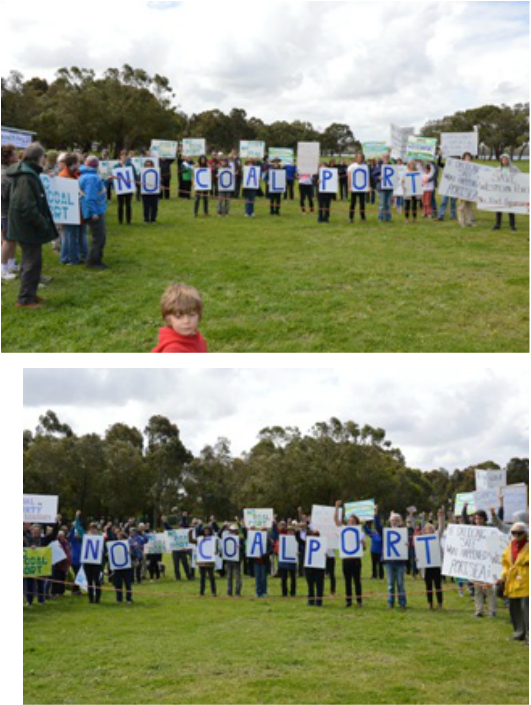 No Port Expansion No Coal Port For Hastings Rally Sat 9th November 2013 went off beautifully. Nearly 200 people came. Plenty of placards and well- received speeches from Karri from WPPC, Tiffany from Quit Coal, Jenny Warfe from Blue Wedges, Mark Wakeham from Environment
Victoria, Dan a farmer from the ninety mile beach and Sue Pennicuik from The Greens. Then we marked out a coal drying area 10m by 10m. In reality if it ever went ahead, it would be 1km by 1km.
No Port Expansion No Coal Port For Hastings Rally Sat 9th November 2013 went off beautifully. Nearly 200 people came. Plenty of placards and well- received speeches from Karri from WPPC, Tiffany from Quit Coal, Jenny Warfe from Blue Wedges, Mark Wakeham from Environment
Victoria, Dan a farmer from the ninety mile beach and Sue Pennicuik from The Greens. Then we marked out a coal drying area 10m by 10m. In reality if it ever went ahead, it would be 1km by 1km.
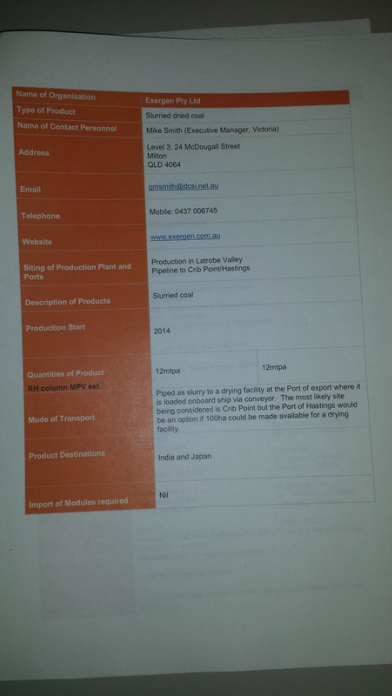
Westernport and Peninsula Protection Council Inc.
No Coal Port For Victoria
No Port Expansion For Hastings
Fun and Informative Community Action
We will be marking out a symbolic area for a coal-drying facility
Fred Smith Reserve Hastings Foreshore
November 9th 2013
2pm-3.30pm
www.wppcinc.org [email protected]
Westernport and Peninsula Protection Council Inc . Reg no A15886H
www.facebook.com/WPPC.Inc Twitter @wppcinc
Brown Coal Export Ports have been proposed for Hastings, The Ninety Mile Beach and Corner Inlet. Gippsland communities concerned with the same threat will attend this action. It is supported By Quit Coal.
No Port Expansion For Hastings
Fun and Informative Community Action
We will be marking out a symbolic area for a coal-drying facility
Fred Smith Reserve Hastings Foreshore
November 9th 2013
2pm-3.30pm
www.wppcinc.org [email protected]
Westernport and Peninsula Protection Council Inc . Reg no A15886H
www.facebook.com/WPPC.Inc Twitter @wppcinc
Brown Coal Export Ports have been proposed for Hastings, The Ninety Mile Beach and Corner Inlet. Gippsland communities concerned with the same threat will attend this action. It is supported By Quit Coal.
The Age Newspaper September 2nd 2013
Penguins at Serious risk if Oil Spill Occurs
ABC TV Sept 2nd 2013
Calls for Port of Hastings expansion to be subject to strict environmental assessment
VIDEO: Environmental warnings over planned container port(7pm TV News VIC)
MAP: Hastings 3915
A Victorian conservation group wants the Federal Government to ensure that plans to expand the Port of Hastings are subject to the strictest possible environmental assessment.
The Victorian National Parks Association is worried about the risk of oil spills harming marine life and damaging coastal wetlands because of an increase in shipping.
It has commissioned modelling of six oil spill scenarios that show relatively small amounts of oil in Westernport Bay could reach the shore within minutes and conservation areas in under six hours.
The association's spokesman, Simon Branigan, says the State Government's plans should be assessed under national conservation laws.
"What we consider is that Westernport is too precious to lose," he said.
"We need proper Federal Government oversight and a comprehensive assessment, using the full force of national environment laws, to make sure that the values of Westernport are protected."
Westernport News has port related articles on pages 6-7
| wpn_current1 |
Westernport and Oil Spill 3 minute video by VNPA and WPPC
View in web browser
MEDIA RELEASE
New research finds Hastings port expansion plan an oil spill disaster in the making
Thursday 28 August 2013
Massive development plans for Victoria’s Westernport Bay will expose the area’s globally significant marine and coastal wetlands to potentially huge damage from oil spills, new research shows.
The findings have sparked calls for the Federal Government to launch an immediate environmental assessment of the Victorian Government’s port expansion plans under national conservation laws.
“The new research found that even relatively small amounts of oil spilled from shipping traffic in Westernport could reach local shorelines within minutes and high conservation areas within less than six hours,” Victorian National Parks Association spokesman Simon Branigan said today.
“We aren’t talking about oil tankers, but rather heavy fuel oil and diesel spills from container ships and port support vessels.”
The research modelled six credible oil spill scenarios based on 27 previous oil spill accidents across Australia since 1970. Computer modelling tracked the spills over a two-week period from two locations within Westernport Bay.
“The modelling shows Phillip Island Nature Park is vulnerable to oil spill contamination, and French Island Marine National Park is also at high risk of exposure. It also highlighted the fact that once oil is in the water, it will be hard to stop.
“Both these parks and many other parts of the bay are home to key roosting, feeding and breeding habitats for waterbirds including annual migrants that breed in Russia, China, Japan and Alaska, spending the summer months feeding in the bay,” Mr Branigan said.
The report was commissioned in response to the Victorian Government’s proposal to expand the Port of Hastings into an international container port, increasing shipping traffic from under 100 ships a year to more than 3000.
Such an increase in shipping is likely to heighten the risk of oil spill.
All of Westernport Bay is listed under the international Ramsar Convention. It is home to 32 species of migratory birds protected by international agreements, making its waters and shorelines subject to national environmental laws.
“Westernport Bay is one of Victoria’s richest marine and coastal environments, and we call for the port expansion plans to have the highest level assessment available under national laws as a matter of urgency,” said Mr Branigan.
The Victorian National Parks Association and the Westernport and Peninsula Protection Council are calling on federal Labor and the Coalition to commit to a comprehensive and independent assessment using the full force of national environmental laws before any further work or money is spent on expanding the port.
“Westernport is Victoria’s marine playground, a unique tidal bay and wetland of international importance with remarkable environmental and recreational values right on the doorstep of Melbourne,” said Westernport and Peninsula Protection Council spokesperson Chris Chandler.
“We are very concerned that the State Government’s plans to turn Westernport into an international container port will expose the bay to a spill disaster, threatening the area’s rich biodiversity including its beautiful beaches, seagrass meadows, native wildlife such as Little Penguins and Black Swan, as well as highly prized recreational fishing species King George Whiting and Snapper.”
Both groups fear the port expansion will require major dredging, the clearing of mangroves to fill in parts of the bay, and road and rail transport corridors through Gippsland, the Mornington Peninsula and suburban Melbourne.
“Expanding the Port of Hastings poses unacceptable danger to Westernport’s unique environmental, social and recreational values,” Mr Branigan said.
“Any proper assessment must consider environmental impacts, all risks and alternative port locations with links to national transport planning.”
The research was commissioned by the Victorian National Parks Association with the Westernport and Peninsula Protection Council, a local community group that has been campaigning against threatened port expansion for 42 years.
Media resources
- Download the report
- Media backgrounder
- Images: Seadragons, birds, fish and natural landscapes of Westernport
- Video: Simulations of the oil spill modelling scenarios – WEB LINK
- Video: Underwater Wonders of Westernport
For comment
- Simon Branigan - 0409 0987 278.

Westernport Protection Campaign Meeting 4
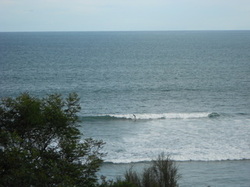
We have several actions ideas and would love more peole to help us to get them done or carry out new ideas.
Balnarring Small Hall Sunday 22nd September 2pm -4pm
[email protected]
Westernport and Peninsula Protection Council Inc . Reg no A15886H
60 minutes expose toxicity of dispersants used in oil spills: Crude Solution
60 minutes Sunday 18th August Dispersants that were used in America on the BP oil disaster 3 years are still highly toxic and have harmed the health of people and the environment. watch this video on this link
Westernport Protection Meeting 3
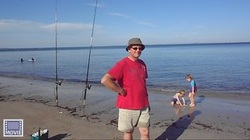
Westernport and Peninsula Protection Council Inc . Reg no A15886H
Balnarring Small Hall Sunday 25th August 2pm -4pm
www.wppcinc.org [email protected] Karri Giles 03 59832 072
Westernport and Peninsula Protection Council Inc . Reg no A15886H
Westernport Protection Meeting

Yes! I love Westernport
Westernport and Peninsula Protection Council Inc . www.wppcinc.org
Invite you to a Westernport Protection Meeting
Balnarring Hall Sunday 14th July 2pm -4pm
Come and share your concerns and ideas to save Westernport. Reg no A15886H
Westernport and Peninsula Protection Council Inc . www.wppcinc.org
Invite you to a Westernport Protection Meeting
Balnarring Hall Sunday 14th July 2pm -4pm
Come and share your concerns and ideas to save Westernport. Reg no A15886H
Community questions Port Of Hastings
The Shire of Mornington Peninsula hosted an update of the Port of Hastings and an open Shire meeting and free dinner on Monday 22nd April 2013.
The new CEO of the Port Of Hastings Mike Lean gave a presentation then answered questions. Then the community asked questions. The first community member politely congratulated the new CEO on his position then asked about the proposed ports likely affect on congestion and pollution in Hastings and Tyabb. One community member waved the local paper and asked about the questions raised about dredging in it last week. (Dredging will be needed Westernport News 16th April) A man asked why the port was going ahead when it seemed to be off the agenda, when it involved government compulsory acquiring land and when the public had held big public meetings in opposition to it. Another community member asked if, as Mike Lean had just said; that Sydney and Brisbane Port had just developed can we use them instead and save us building the proposed Port of Hastings? Then questions were finished. While there may have been people present in the audience that were in favour of port development, there were no positive comments from the community at all and in fact an unwillingness to accept it was evident.
The new CEO of the Port Of Hastings Mike Lean gave a presentation then answered questions. Then the community asked questions. The first community member politely congratulated the new CEO on his position then asked about the proposed ports likely affect on congestion and pollution in Hastings and Tyabb. One community member waved the local paper and asked about the questions raised about dredging in it last week. (Dredging will be needed Westernport News 16th April) A man asked why the port was going ahead when it seemed to be off the agenda, when it involved government compulsory acquiring land and when the public had held big public meetings in opposition to it. Another community member asked if, as Mike Lean had just said; that Sydney and Brisbane Port had just developed can we use them instead and save us building the proposed Port of Hastings? Then questions were finished. While there may have been people present in the audience that were in favour of port development, there were no positive comments from the community at all and in fact an unwillingness to accept it was evident.
Port Of Hastings involves Dredging - Press Releases April 2013 Shorter copy
Last Week Dennis Napthine said that a port in Westernport was preferred over the Bay West option because Bay West would need significant dredging. Westernport would need significant dredging too. This is mentioned in the document Community Reference Group- Options Briefing Dept of Infrastructure, Port of Hastings and Maunsell. Oct 2005 :…..recommends deepening of Channel [from 14.3m] to 16m . The channel is a long way from the proposed wharf and would require dredging and significant dredging has been proposed just to establish the wharf. Drawings from pg. 10 to 14 of the proposed plan show areas of 1.5kms to more than 4kms long, and 600m to 750m wide hatched to depict potential dredging areas. In addition to this there is an 800m basin hatched into seagrass flats for Dry Bulk. Ships also need turning circles and the plan is to anchor them near Phillip Island which has potential to wreck the bottom too.
This has terrible risks as outlined by the Melbourne Water Westernport Scientific Study; suspended sediment can kill the plants and animals that are keeping Westernport healthy. Sea-grass loss, algal blooms and eutrophication can result. Melbourne’s healthy enjoyment of Westernport for fishing, surfing, holidays, camps, and tourism into the future is at stake.
.......... Karri Giles President, Westernport and Peninsula Protection Council
2
The Angry Summer
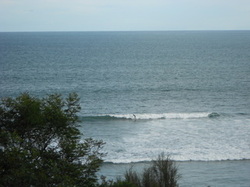
A surfer at Merricks
Westernport Bay.
Westernport Bay.
Stop Press
Our secound you tube clip is now availiable for watching. Thanks Ian Cuming for a great summary from some knowable speakers about marine pests, shipping, oil spills, dredging and emissions from shipping. As well as about the magic of the ecology of Westernport Bay. Check out this secound clip and like it . Just click on it once.
http://www.youtube.com/watch?v=ZhfKNc8lRjA&feature=relmfu
Check the first of our Youtube clips
From our Seminar 40 of Protecting Westernport Bay 40 years of WPPc and 40 years of Ramsar the International Wetland Convention
Speakers from WPPC, Blue Wedges, Wild about Westernport, Victorian National Parks Association and Australian Seabird Rescue
October 2011
This is the sharing link http://www.youtube.com/watch?v=yLDtc_YeYrU
WPPC Inc. support and promote the protection of the environment of Westernport and the Mornington Peninsula. Founded in 1971
Is Westernport Bay a deep Bay?
No, If you are in a sailing ship, sailing west from Sydney, Westernport Bay is true to its name and can be seen as deep, and historically has been seen as deep. Big industrial ships are too big For Westernport Bay. Westernport Bay is so shallow 42 Percent of it is above the waterline at each low tide. Intertidal mud flats mean that the shipping channel is the only deep area in the north-western section. Myself; Karri Giles, Jenny Warfe, Catherine Manning, Simon Branigan and all the other attendees of the Westernport Catchment Committee were given a presentation including maps of Westernport Bay's shipping channel. Which showed the depth of it. It looked more like a chain of ponds, with many shallower bits than the average depth.We asked Shane from Patricks Ports for a copy of the maps and we were told that his bosses probably wouldn't want us to have them. Maunsell have reccomended dredging from 14.3m to 16m to allow ships to enter without awaiting the tides. Dredging would spoil the invertebrate communities that live in the deep area. 75 percent of the marine life in the Southern Australia are endemic and live no where else. Apart from the immediate effect of dredging,digging up seagrass which has a blanket of roots would have a long term effect of removing nature's erosion control blankets. You can see seagrass roots washed on our beaches, I can't imagine anything more important to protect than living seagrass. Dredging is enough to stir up turbidity to the point that algae blooms or eutrophication could result. The nutrients in Westernport Bay are a key environmental threat. It looks like Northern Pacific Sea-star has colonised in huge numbers in the Southern Peninsula's after the famous channel deepening there.Thousands of sea- stars have been seen for the first time in areas they have never been seen before.
write up of last summer's WPPC AGM January 15th 2012 10.30am Balnarring Hall
Guest Speaker- Sue Penicuik MLC
We were honoured this year by having Greens MP Sue Penicuik to Speak at our AGM. she is a long time champion of the environment. She outlined the efforts she has gone to and the limits of political action, and gave us a few ideas for protecting Westernport Bay .It was a good day with a few new faces and a yummy lunch afterwards.
We were honoured this year by having Greens MP Sue Penicuik to Speak at our AGM. she is a long time champion of the environment. She outlined the efforts she has gone to and the limits of political action, and gave us a few ideas for protecting Westernport Bay .It was a good day with a few new faces and a yummy lunch afterwards.
Last Year's Oil Spill Seminar event
40 Years of Westernport and Peninsula Protection Council Inc.
40 years of Ramsar- The International Wetland Convention
Somers Yacht Club
The
Boulevard Somers Mel 194 A10
Thursday 27th October 2011
Marny Bonner was the guest speaker at the seminar at Somers Yacht club organised this year by WPPC. She talked about her experiences as sea-bird rescuer attending the Gulf of Mexico oil spill. She had photos of birds and the precious coastline, covered in oil. Aspects of the coast making cleaning up very difficult, as it would in Westernport Bay. Her photos of oil-spill operations trucks commandeering the public open space on the coastline. The media trucks took up any remaining areas. She also said that before the oil spill the mouth of the Mississippi was a dead-zone due to stormwater pollution.Marny Bonner from Australian Sea-bird Rescue focussed
her attentions on teaching the locals how to clean birds, as every year now for
years as they return on their migration, it is expected that they will be oiled
by the oil still in the environment. Gordon Fraser-Quick environmental consultant gave a general address about oil spills, the frequency of oil spills and the myth of “clean up”.
Brian Cumming from WPPC presented oil spill modelling for Westernport Bay; and the fact that Westernport Bay is unsuited as an industrial port.
After Lunch, Jenny Warfe from Blue Wedges spoke about the different threats from shipping: including exhaust emissions, disabled ships and spills of chemicals and rubbish.
Catherine Manning introduced Wild about Westernport and campaign ideas including using you-tube clips and an on-line petition.
Matt Ruchel from VNPA discussed campaign ideas and announced the up and coming Going backwards Under Baillieu Rally and the need to raise money for an economic study of The Bay.
Karri Giles from WPPC tabled the report by Dr Jeff Ross which highlights the importance of benthic organisms for de-nitrification, or in other words why we need to prevent an oil spill or turbidity in Westernport Bay to keep the molluscs and crustaceans alive that play a role in cleaning the water.
We celebrated 40 years of Ramsar by showing the official you-tube clip about the importance and beauty of Wetlands around the World.
40 years of Ramsar
40 years of WPPC
Westernport Bay legislation sets Govt on collision course with environment and community groups
Thursday, 30 June 2011New legislation due to be debated in State Parliament today will set the Government on a collision course with environment and community groups over plans to expand the Port of Hastings in Westernport Bay.
The legislation will establish a new Port of Hastings Development Authority to fast-track plans to expand the port and transform the area into a highly urbanised industrial zone, projected to be busier than the Port of Melbourne.
“The primary purpose of this new legislation is to encourage the rapid expansion of the Port of Hastings into a container port, with little consideration of protecting and enhancing Westernport Bay’s immense environmental and recreational values,” said the Victorian National Parks Association’s Marine and Coastal Project Officer Simon Branigan.
“The new legislation for the Port of Hastings Development Authority should have the protection of the Bay’s environmental values as its core operating goal, not just fast-tracking development based on a projected growth in container shipping traffic.”
Blue Wedges Coalition spokesperson Jenny Warfe said once the development proceeds to the Environmental Effects Statement (EES) phase the proponents control the process, with economics being the focus, not the environment.
“EES assessments of major infrastructure projects have invariably relied on economic analyses which ignore any assessment of the costs of environmental services lost - nor have they objectively assessed the real economic benefits of the proposed development."
“According to a 2006 Port of Hastings Land Use and Transport Strategy Report, the port will have a capacity of 3.7 million shipping containers per annum by 2035, so it will be even more busy and congested than the Port of Melbourne which currently handles around 2.2 million containers per year.“
The Westernport and Peninsula Protection Council’s Karri Giles said the expansion plans could ruin the bay’s fragile marine environment, including internationally significant Ramsar-listed wetlands.
“It’s unbelievable that in the 40th anniversary year of the Ramsar Convention on Wetlands, the Government is proposing a massive industrial container shipping port that could result in the death of Westernport Bay as a healthy functioning ecosystem and place for recreation.”
Last November, 16 environment and community groups released a joint statement calling for a halt on Port of Hastings expansion plans based on the huge impact this development would have on Westernport’s environmental and recreational values.
For comment
- Simon Branigan, Vic National Parks Assoc8 Jenny Warfe, Blue Wedges Coalition, .
- Karri Giles, Westernport and Peninsula Protection Council,
Penguin Island now available on DVD from ABC shops
Penguin Island is narrated by Rolf Harris and airs in six half hour episodes www.360degreefilms.com.au


